102 Fields at work
Essential Idea:
Similar approaches can be taken in analysing electrical and gravitational potential problems
Understandings:
- Potential and potential energy
- Potential gradient
- Potential difference
- Escape speed
- Orbital motion, orbital speed and orbital energy
- Forces and inverse-square law behaviour
Applications and Skills:
- Determining the potential energy of a point mass and the potential energy of a point charge
- Solving problems involving potential energy
- Determining the potential inside a charged sphere
- Solving problems involving the speed required for an object to go into orbit around a planet and for an object to escape the gravitational field of a planet
- Solving problems involving orbital energy of charged particles in circular orbital motion and masses in circular orbital motion
- Solving problems involving forces on charges and masses in radial and uniform fields
Data booklet reference:
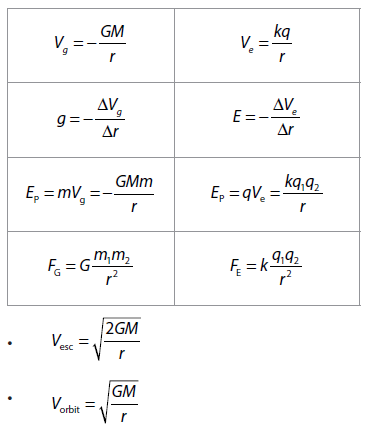
ELECTROSTATIC POTENTIAL AND CAPACITANCE
ELECTROSTATIC POTENTIAL
Electric potential at a point in an electric field is defined as the amount of work done in bringing a unit positive test charge from infinity to that point along any arbitrary path. (Infinity is taken as point of zero potential). It is denoted by V ;

Its SI unit is JC–1 or volt. It is a scalar quantity.
Also, electric potential at any point in an electric field is defined as the negative line integral of the electric field vector from a point infinitely away from all charges to that point
i.e. 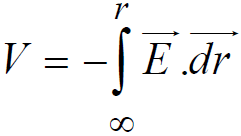

POTENTIAL DUE TO A POINT CHARGE
The electric potential due to a point charge q at separation r is given by
(Please note that we have to write q with its sign in this formula)
4F potential difference between two points is the work done in bringing unit positive charge from one point to another.
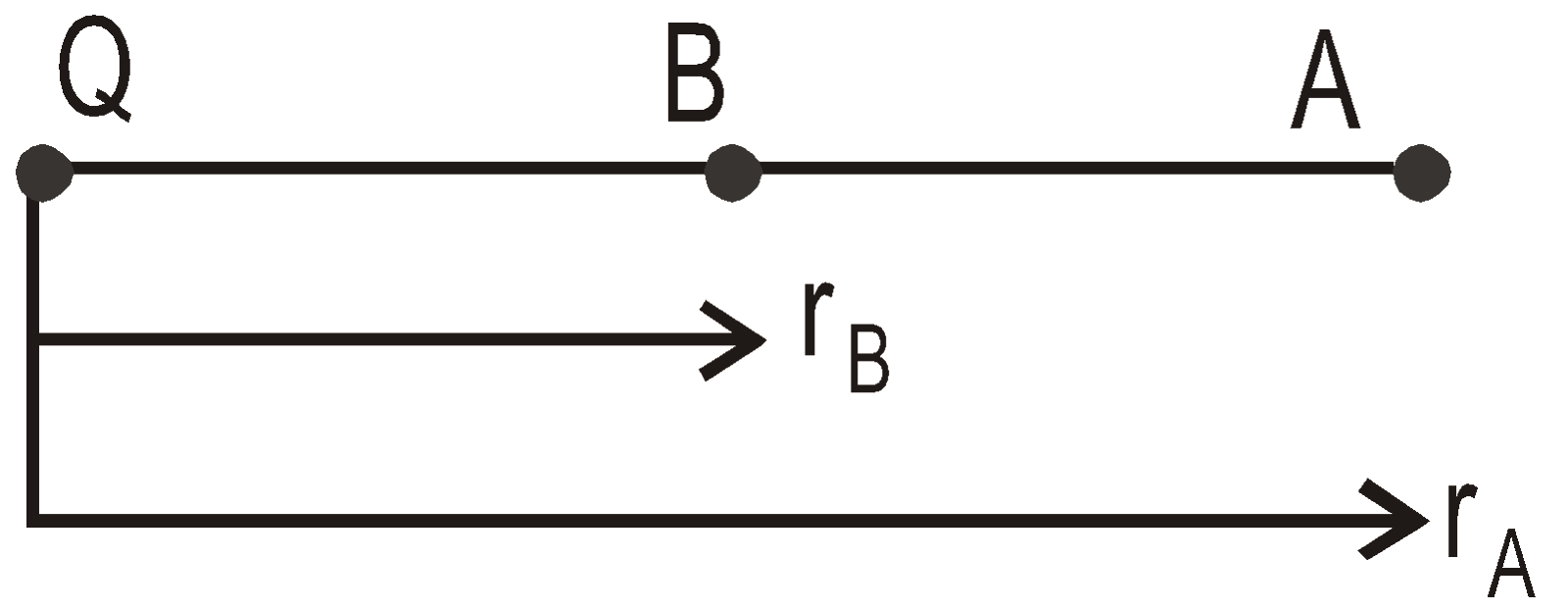
VAB = VB – VA 
 J/C
J/C
POTENTIAL DUE TO CONTINUOUS CHARGE DISTRIBUTION
The potential due to a continuous charge distribution is the sum of potentials of all the infinitesimal charge elements in which the distribution may be divided.
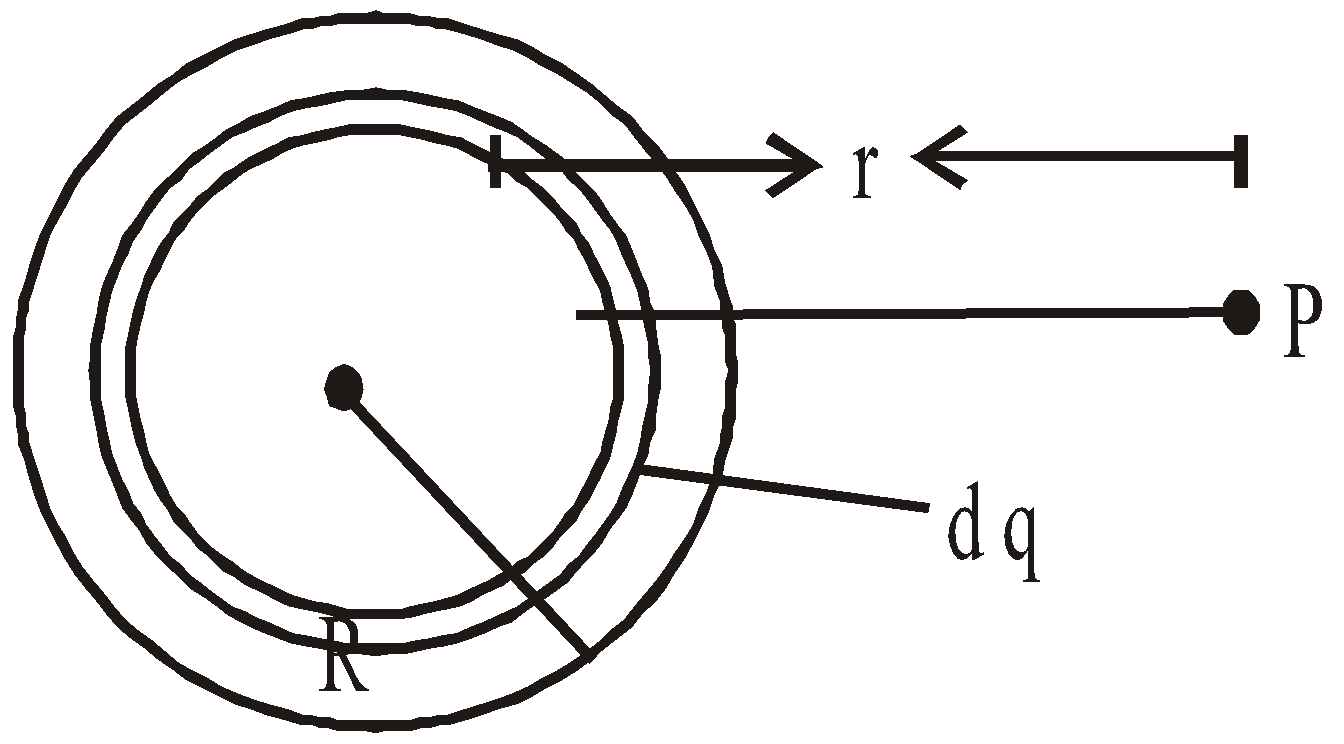
i.e.  where
where 
POTENTIAL DUE TO A SYSTEM OF CHARGES
The electric potential due to a system of charges q1, q2, …qn is
V = V1 + V2 + … + Vn
V = V1 + V2 + … + Vn
where ri is the point from charge qi and ε is the permittivity of medium in which the charges are situated.
Potential at any point P due to a point charge q at a distance (r1 + r2) where r1 is the thickness of medium of dielectric constant x1 and r2 is the thickness of the medium of dielectric constant k2
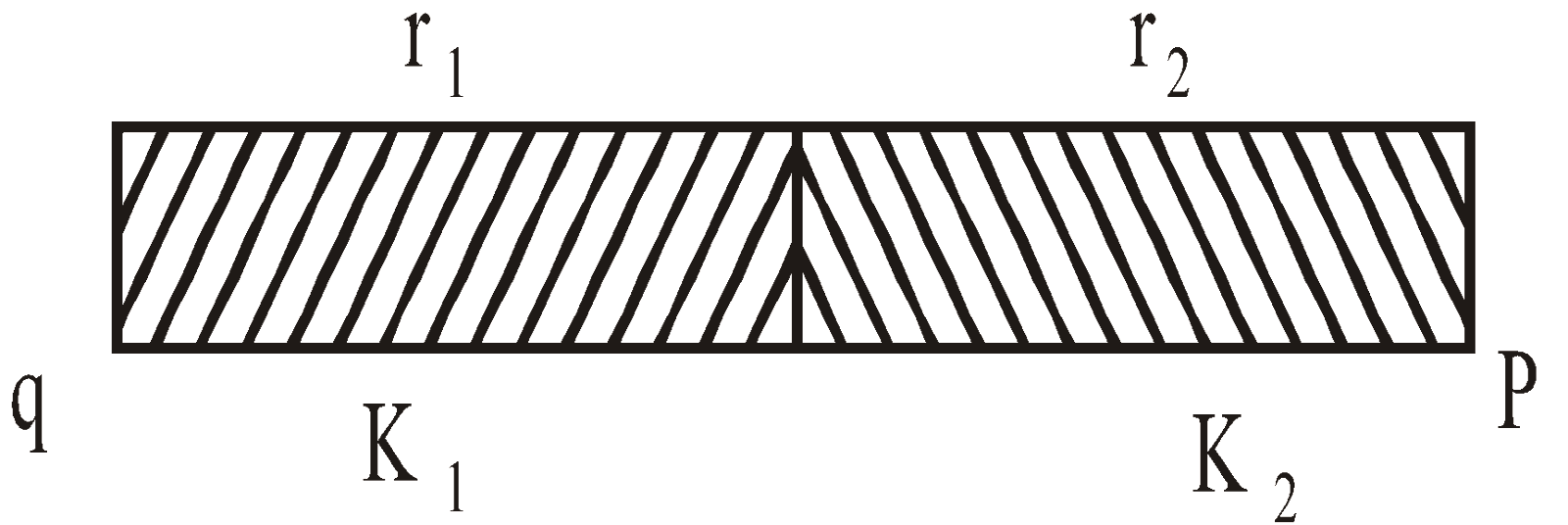
RELATION BETWEEN ELECTRIC FIELD AND POTENTIAL
The relation between electric field (E) and potential (V) is 
For 3-D we can write
So electric field is equal to negative potential gradient.
In this relation negative sign indicates that in the direction of electric field, potential decreases. Consider two points A and B situated in a uniform electric field at a distance d then,
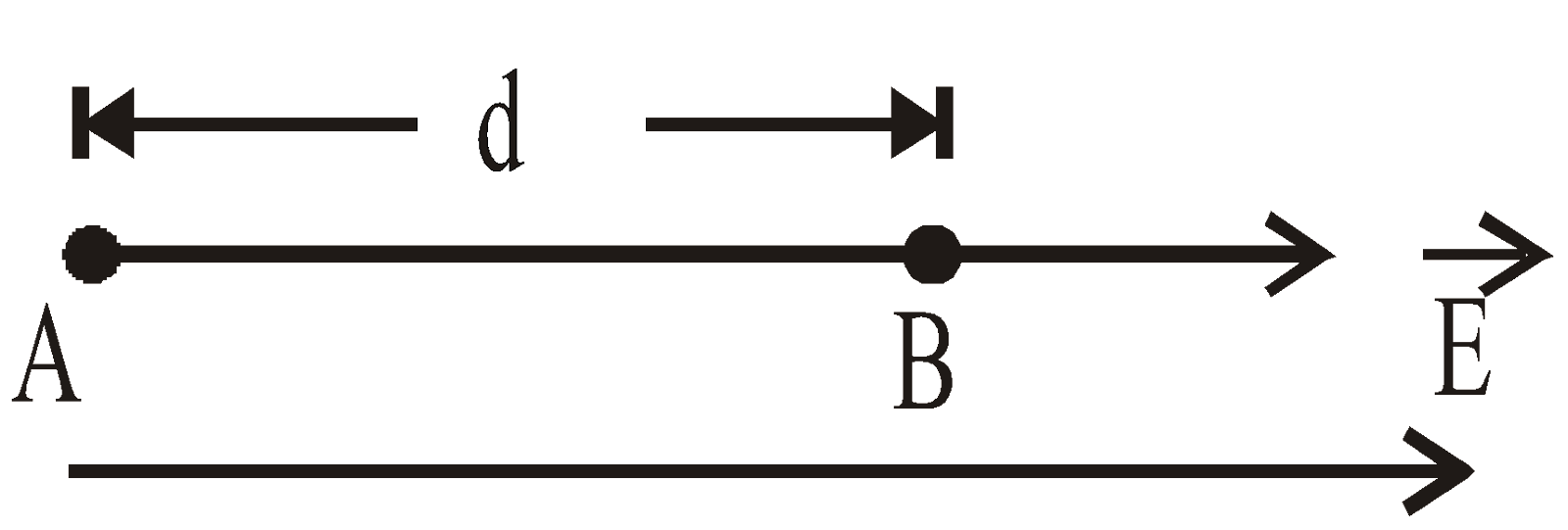
The potential difference between A and B is
CONSERVATIVE NATURE OF ELECTRIC FIELD
The electric field is conservative in nature. In figure the work, WAB has the same value whatever path is taken in moving the test charge.
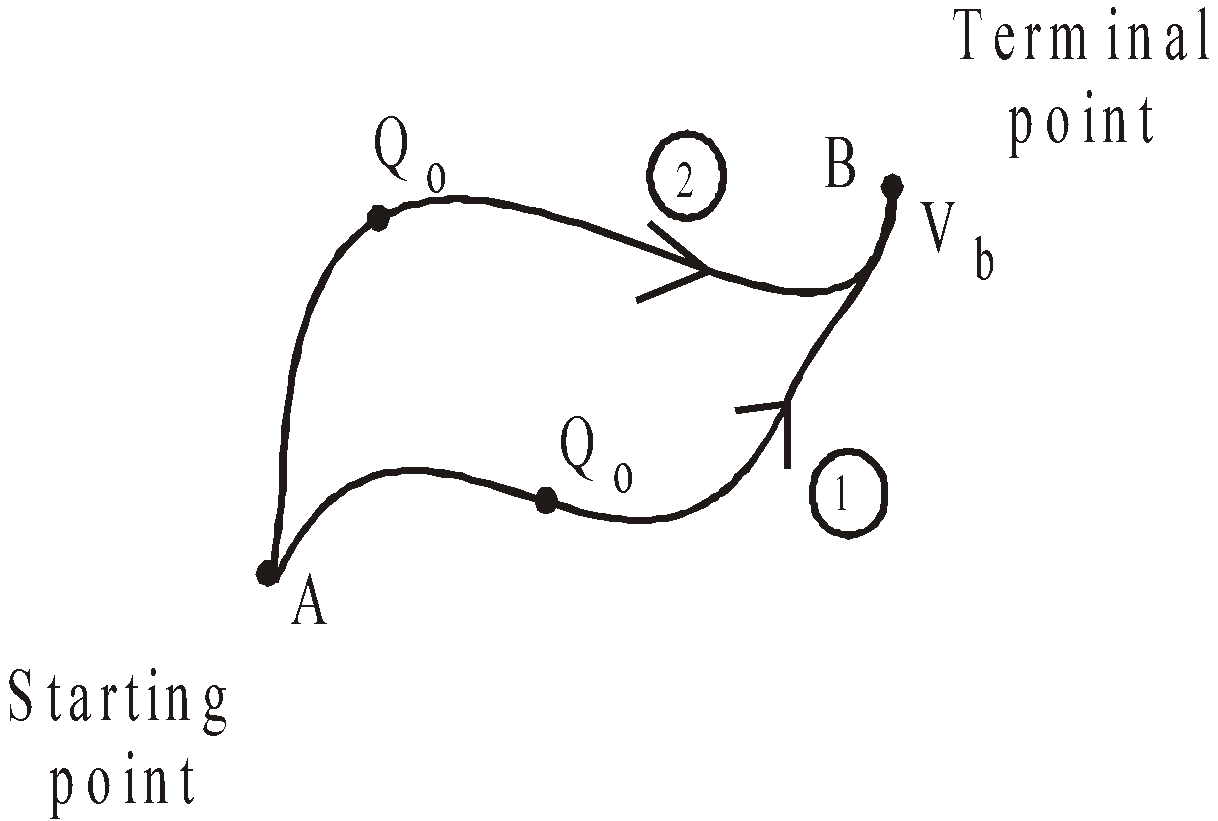
so, 
has the same value for any path between A and B and VB and VA are unique for the points A and B.
Note:- We cannot find the absolute value of potential therefore conventionally, we take infinity as the point of zero potential. If need arises, we can assume any point to be the point of zero potential and find the potential of other points on this basis.
POTENTIAL ENERGY OF A SYSTEM OF CHARGES
Potential energy can be defined only for those forces, which are conservative, such as gravitational and electrostatic forces. The potential energy of a charge between two points is defined as the amount of work done in bringing the charge from one point to another.
i.e. 

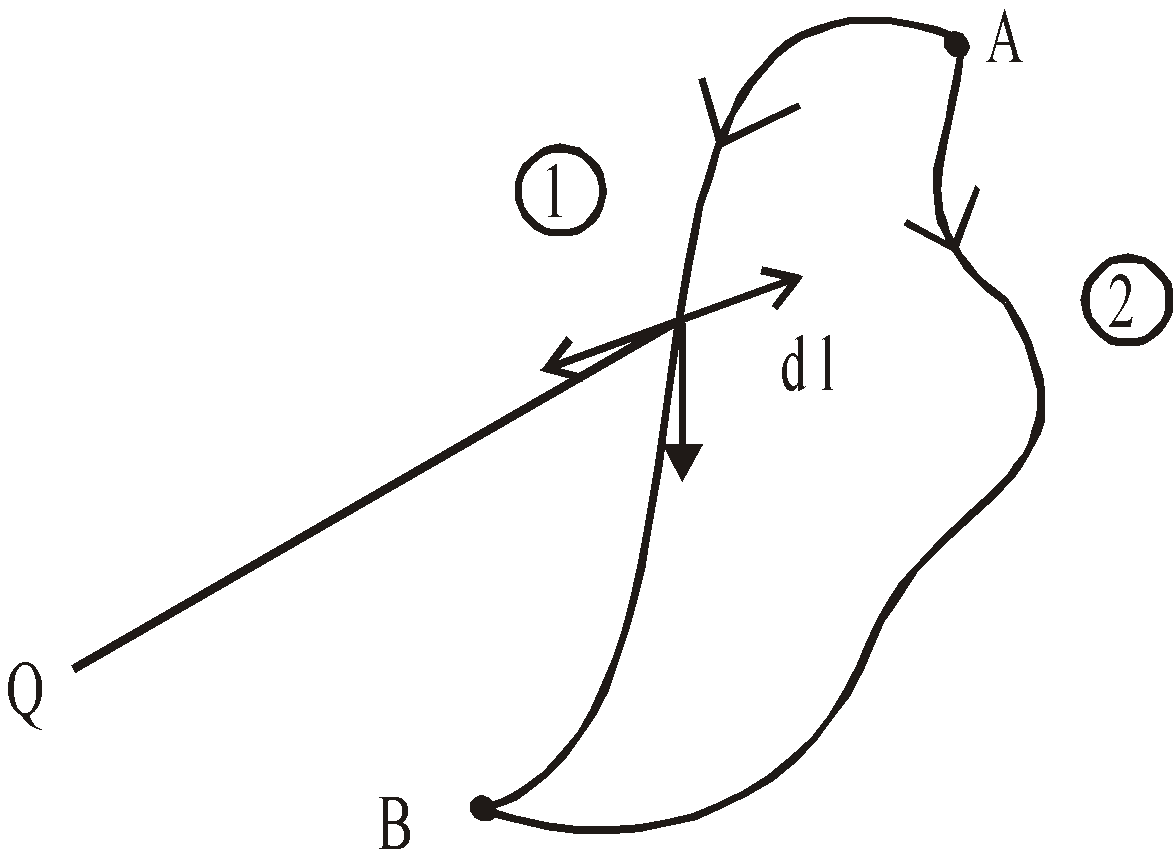
Calculation of external work done against the field and a point charge Q in moving a test charge q from A to B. For a conservative field the work done by any path is same. The sectional force is – qE.
If A is at infinity then at infinity since potential is zero we assume infinity as reference point,VA = 0

Potential energy of a system of two charges Q1 and Q2

Note:- In this formula we have to write charges with sign
Potential energy of a system of three charges Q1, Q2 and Q3
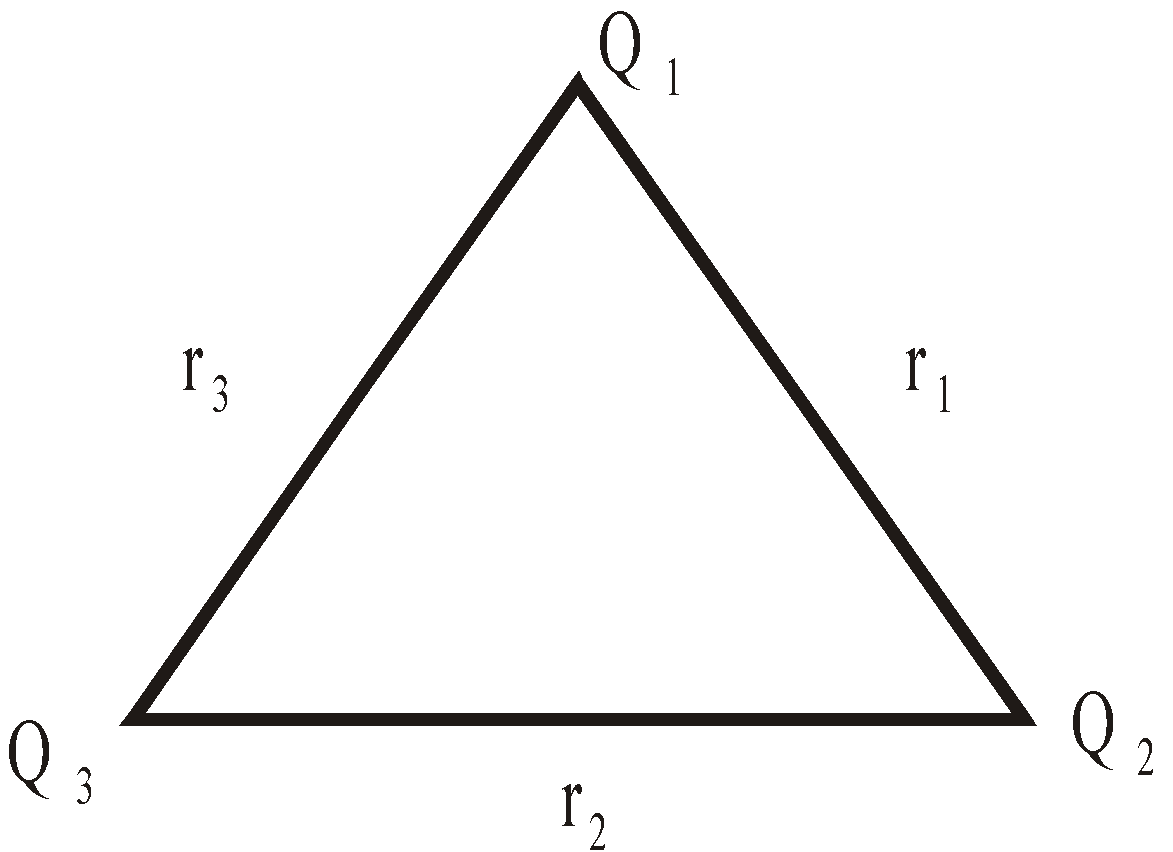

KEEP IN MEMORY
- For an assembly of n charges
[Total number of intersection ] the potential energy is
] the potential energy is

- For a system of two charges.
If Usystem = –ve, then there is net force of attraction between the charges of the system.
If Usystem = +ve, then there is net force of repulsion between the charges of the system
Usystem = max for unstable equilibrium
Usystem = min for stable equilibrium
Also 
- The energy required to take away the charges of a dipole at infinite distance

- The work done when a charge q is moved across a potential difference of V volt is given by W = qV
- When one electronic charge (1.6×10–19 coulomb i.e., charge of electron) is moved across one volt the work done is called one electron volt (eV). Thus 1eV = (1 volt) × (1.6×10–19 coulomb) = 1.6×10–19 joule.
EQUIPOTENTIAL SURFACE
It is that surface where the potential at any point of the surface has the same value. The electric lines of force and the equipotential surface are mutually perpendicular to each other. No work is done in moving a charge from one point to other on an equipotential surface. Work is done in moving a charge from one equipotential surface to another.
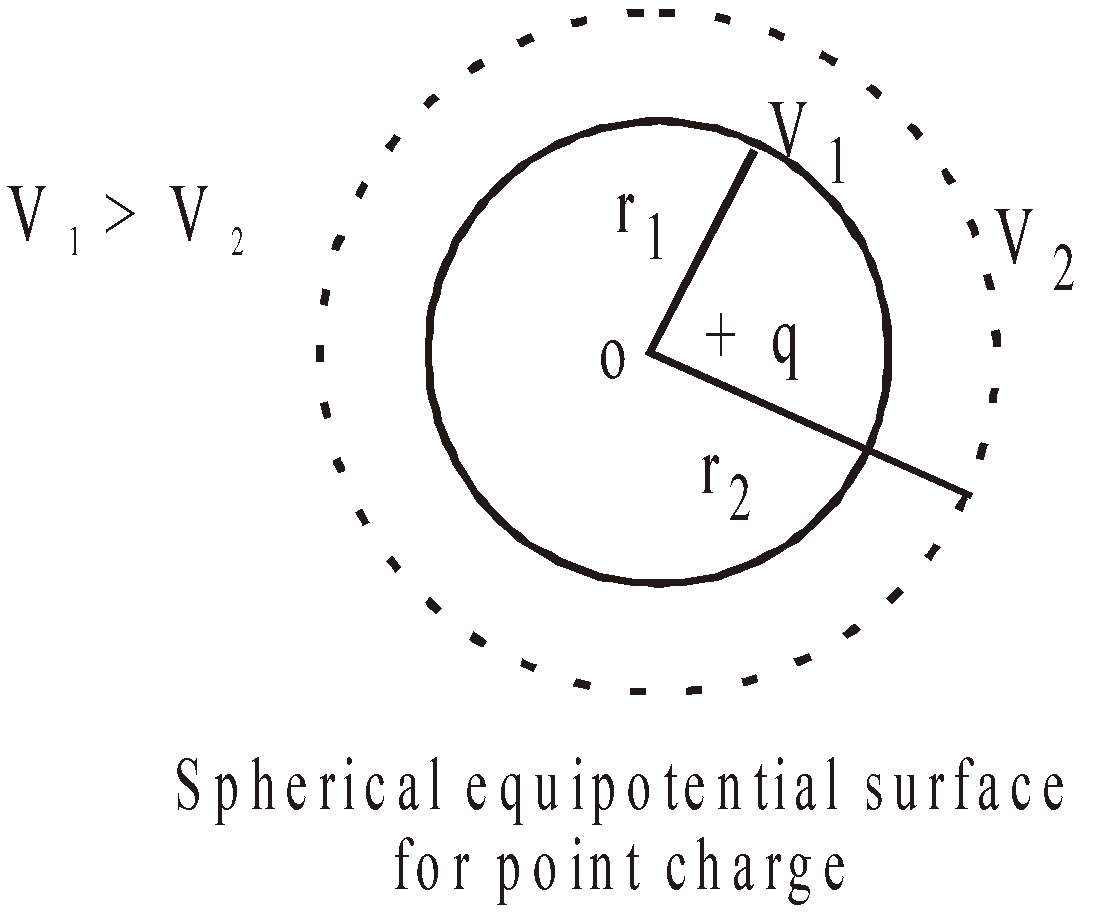
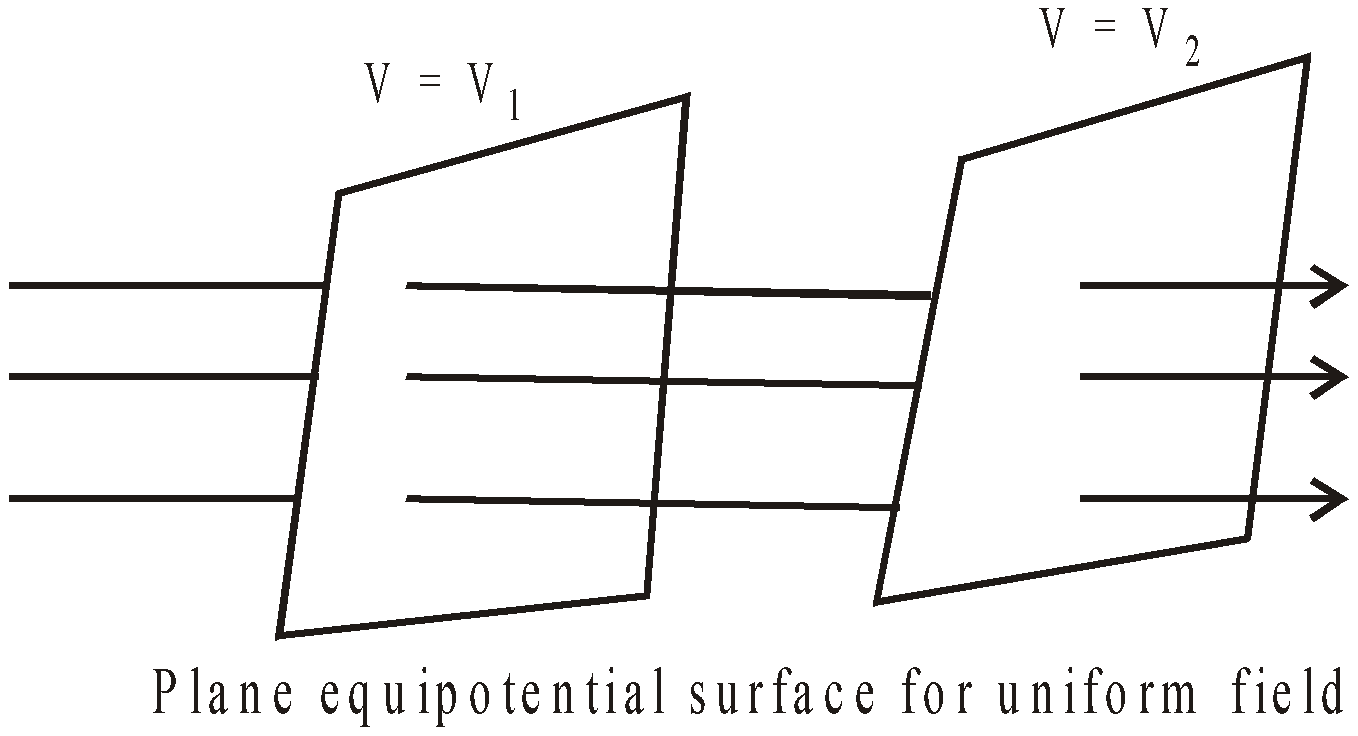
Equipotential surface do not cut each other.
The density of the equipotential lines gives an idea of the strength of electric field at that point. Higher the density, larger is the field strength.
POTENTIAL DUE TO VARIOUS CHARGE DISTRIBUTION
- Electric potential due to isolated point charge

- A circular ring of radius R with uniformly distributed charge Q
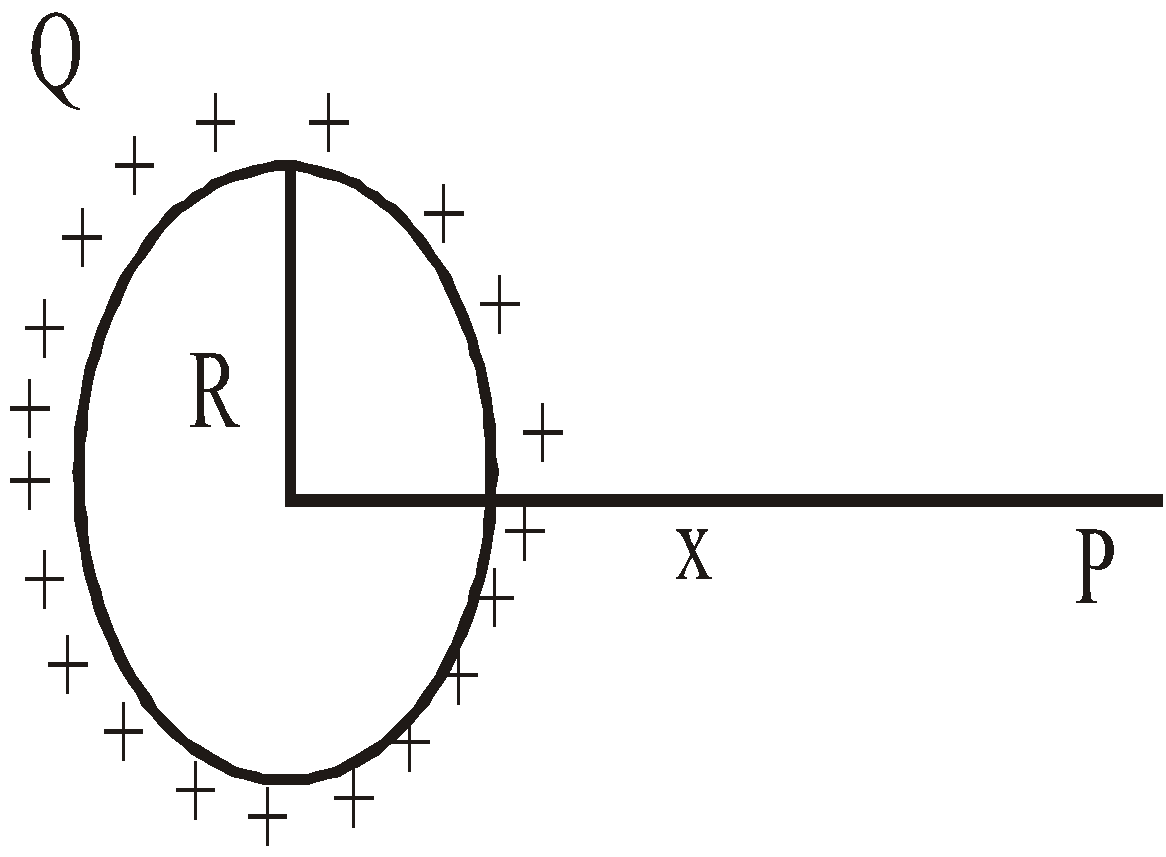
Potential V does not depend on the way of charge distribution on the ring (uniform / non-uniform).
- A circular disc of radius R with uniformly distributed charge with surface charge density σ
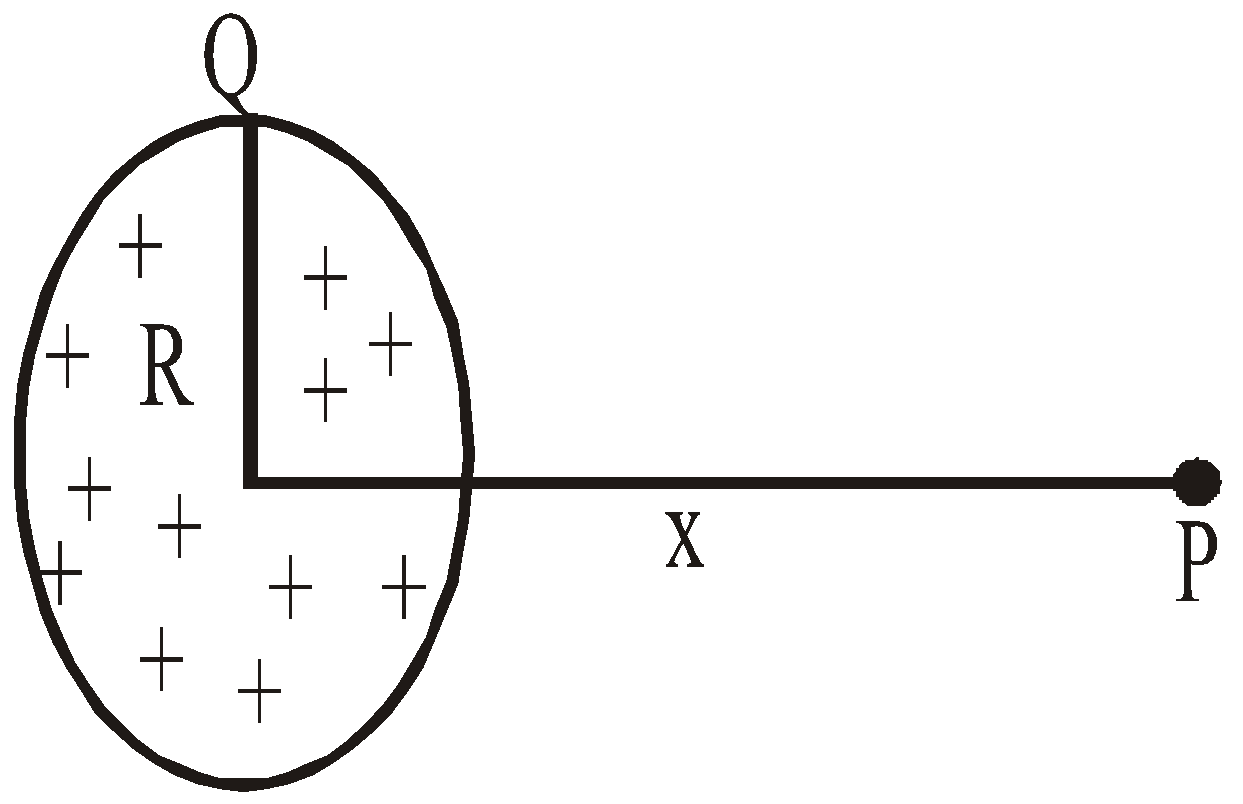
- A finite length of charge with linear charge density
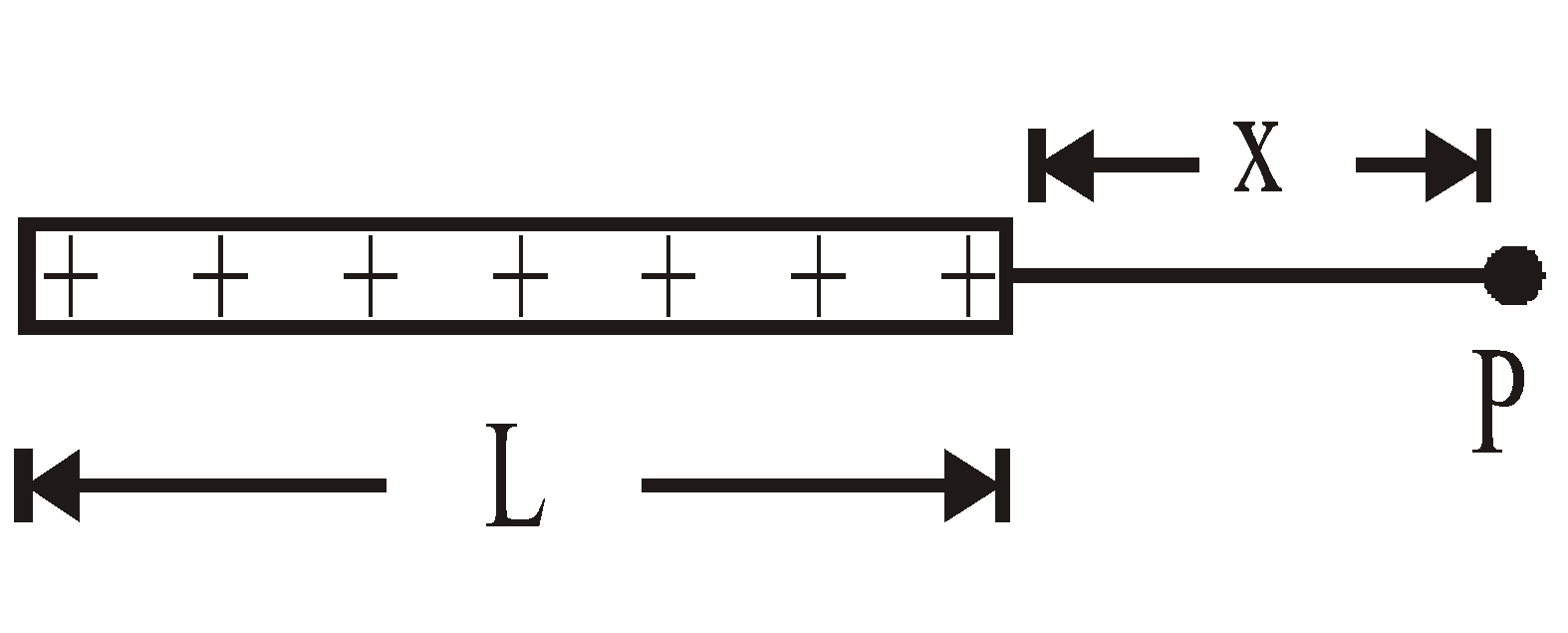
- Due to a spherical shell of uniformly distributed charge with surface charge density σ
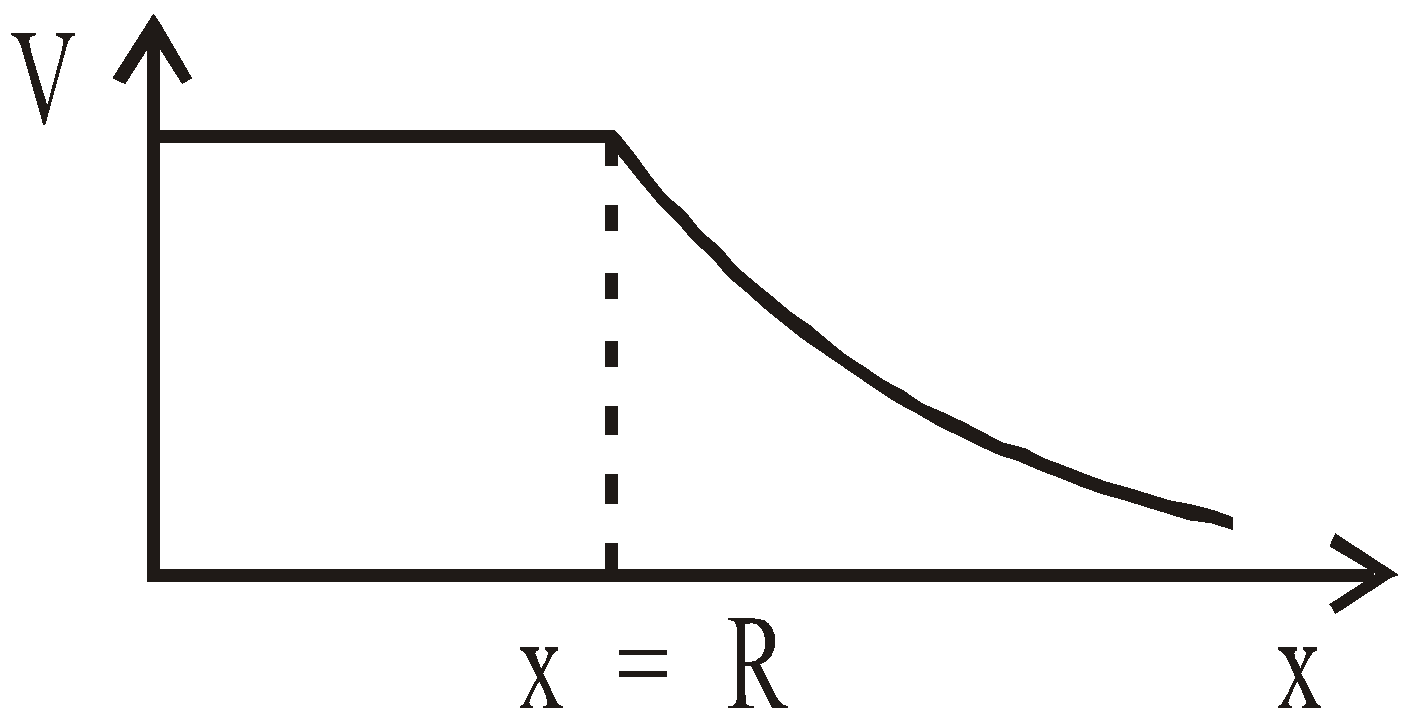
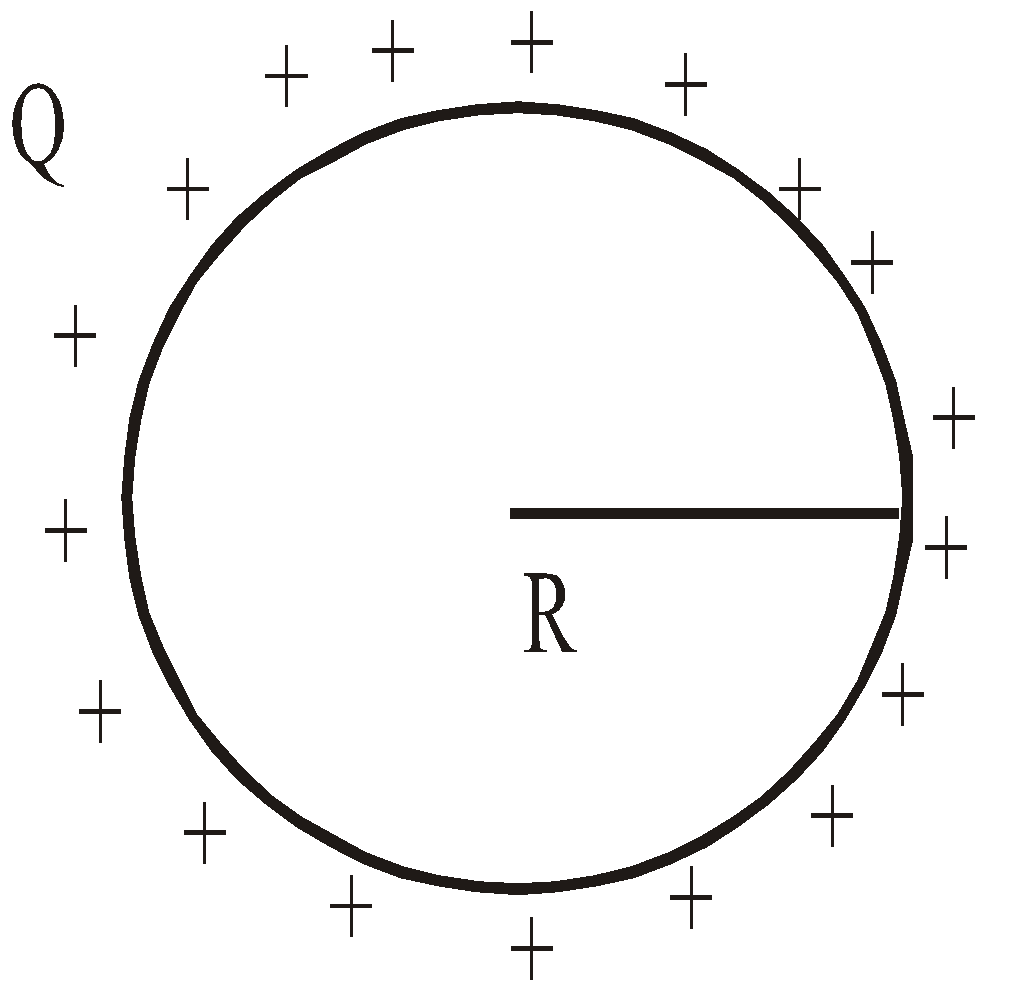
- Due to a solid sphere of uniformly distributed charge with volume charge density ρ.
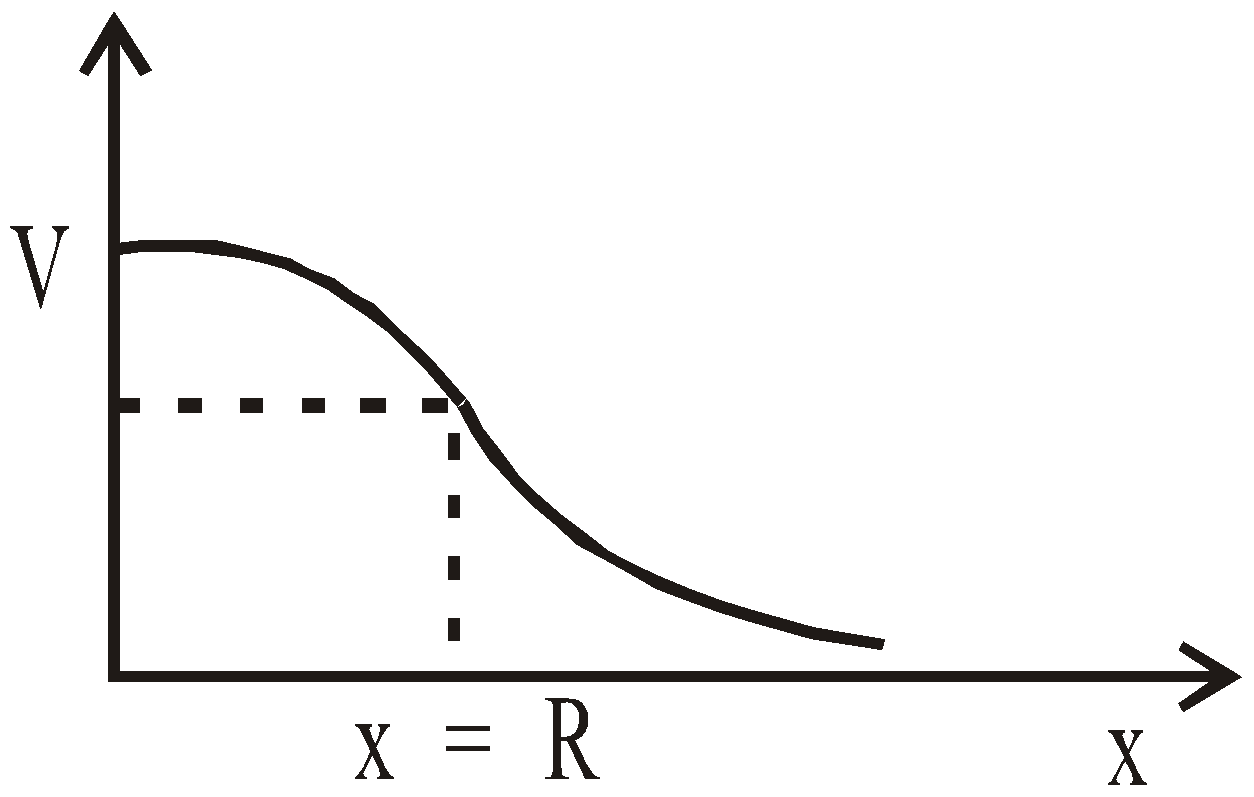
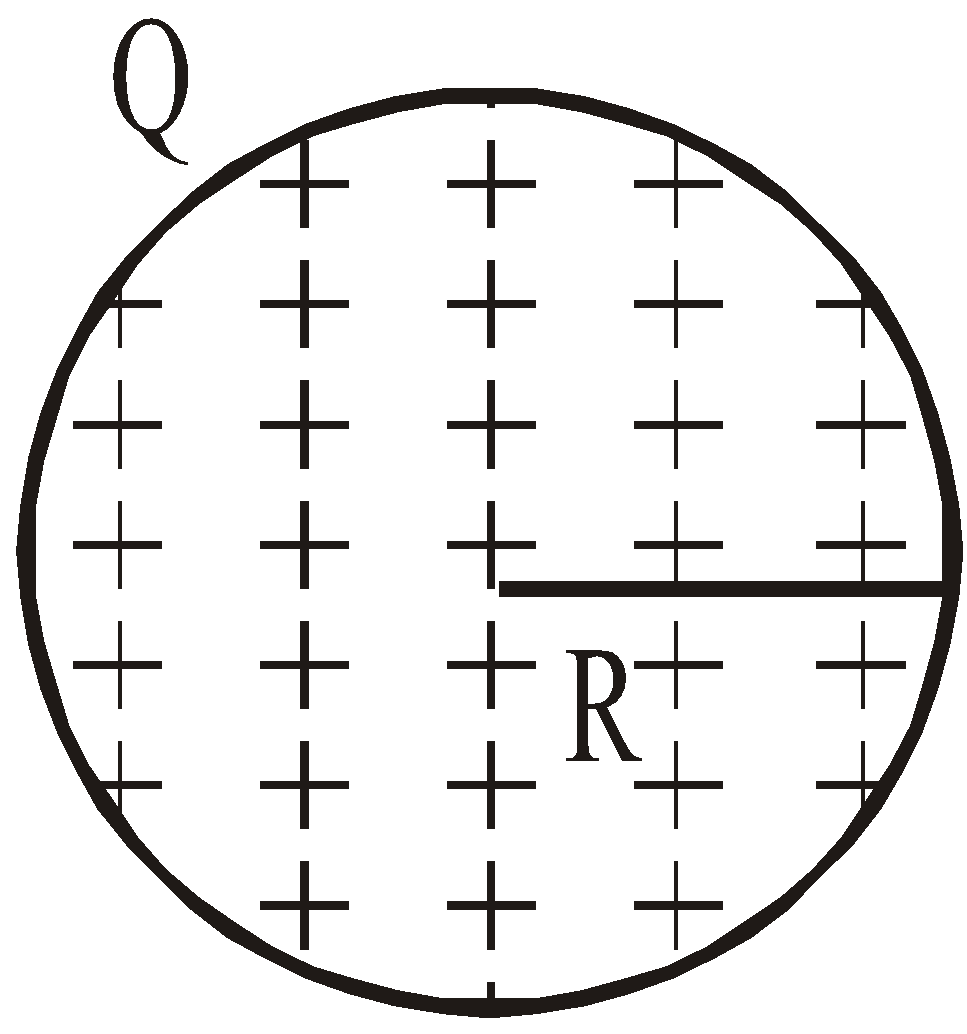
POTENTIAL DUE TO ELECTRIC DIPOLE
- Along axial line :

- Along equatorial line : Veq = zero
- At any point from the dipole :
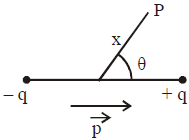
KEEP IN MEMORY
- Electric field inside a charged conductor is zero
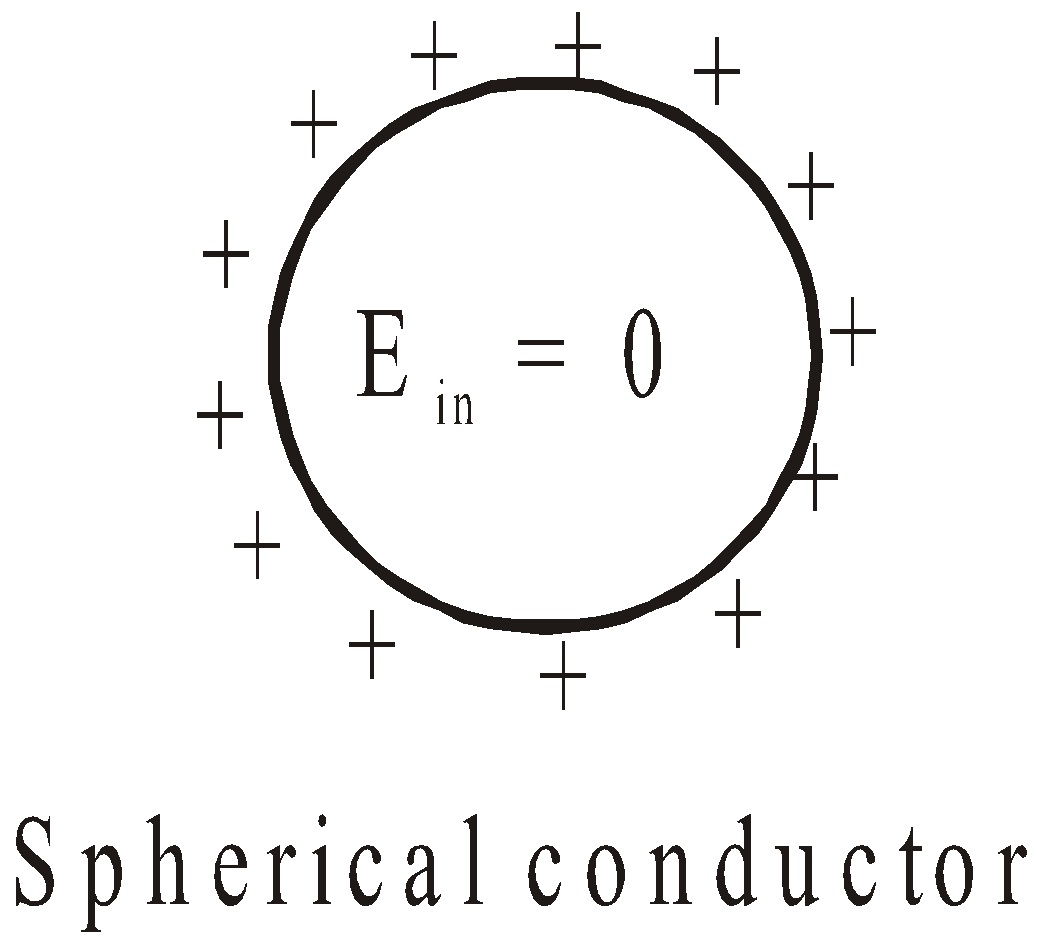
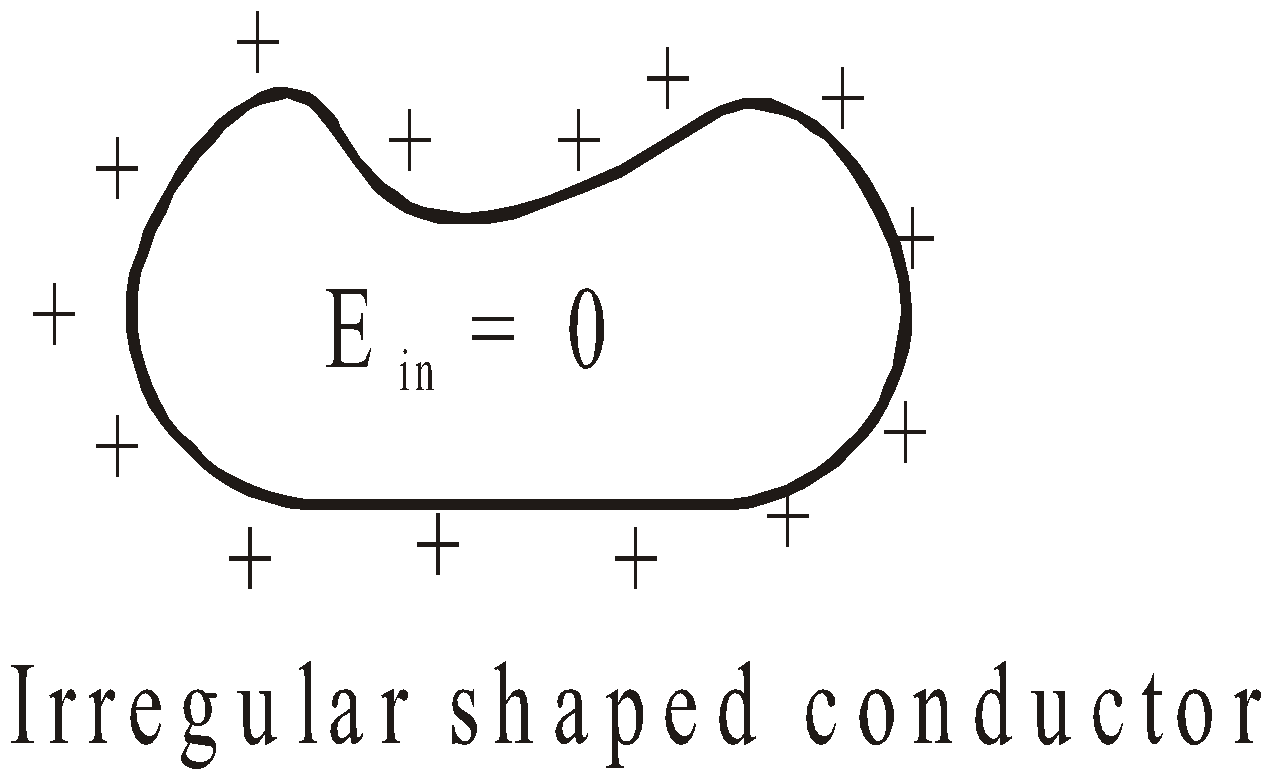
But in both the cases the potential at all the points of the surface will remain the same. But charges will have same distribution on spherical conductor and in case of irregularly shaped conductor the charge distribution will be non-uniform. At sharp points, charge density has greatest value.
- Electronic lines of force are always perpendicular to the equipotential surfaces.
- The work done in moving a charge from a point to the other on an equipotential surface is zero as the potential difference between the two points is zero.
- The electric potential at a point due to a point charge decreases (or increases) by K-times if the distance between the charge and the point increases (or decreases) by K-times.
- A ring with a charge distribution behaves as a point charge for the points very far from its centre.
- The electric potential is constant inside a hollow charged sphere and it is also equal to its value on the surface but it varies inversely with the distance outside the sphere.
- The electric potential at points inside a solid sphere has a non-zero value and decreases as we go from the centre outwards. It behaves as a point charge for the points outside the sphere.
- The electric potential at a point due to a dipole varies directly with the dipole moment.
COMMON DEFAULT
Incorrect : Where electric field is zero, electric potential is also zero.
Correct : It is not always correct, for example in a charged conducting shell, electric field inside the shell E = 0 but potential is not zero.
Incorrect : Where electric potential is zero, electric field is also zero.
Correct : It is not always correct. In the case of equatorial plane of an electric dipole the electric potential is zero but the electric field is non-zero.
ELECTROSTATICS OF CONDUCTORS
Conductor is a substance that can be used to carry or conduct electric charges. Metals like silver. Copper, aluminium etc. are good conductors of electricity.
Regarding electrostatics of conductors following points are worth noting.
- Inside a conductor, electric field is zero.
- The interior of a conductor can have no excess charge in static situation.
- Electric field at the surface of a charged conductor is

where, s = surface charge density
- Electric field just outside a charged conductor is perpendicular to the surface of the conductor at every point.
- Electrostatic potential is constant throughout the volume of the conductor and has the same value as on its surface.
- Surface density of charge is different at different points.
CAPACITORS AND CAPACITANCE
A capacitor or condenser is a device that stores electrical energy. It generally consists of two conductors carrying equal but opposite charges.
The ability of a capacitor to hold a charge is measured by a quantity called the capacitance. Let us consider two uncharged identical conductors X and Y and create a P.D. (Potential Difference) V between them by connecting with battery B as shown in figure.
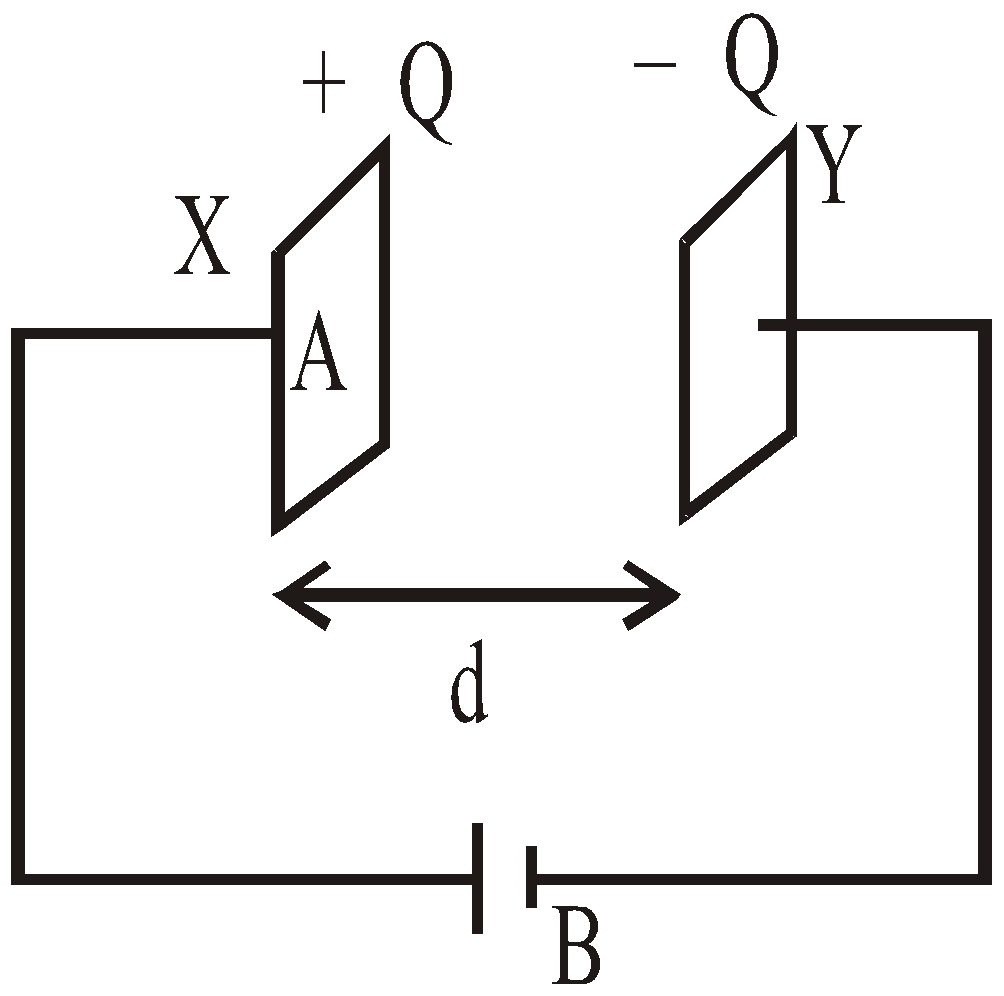
Fig- A capacitor consists of electrically insulated conductors carrying equal positive and negative charge
After connection with the battery, the two conductors X and Y have equal but opposite charges. Such a combination of charged conductors is a device called a capacitor. The P.D. between X and Y is found to be proportional to the charge Q on capacitor.
The capacitance C, of a capacitor is defined as the ratio of the magnitude of the charge on either conductor to the magnitude of P.D. between them.
Capacitance is always a positive quantity.
The S.I. unit of capacitance is coulomb per volt or farad (F).
Furthermore, the value of capacitance depends on size, shape, relative positions of plate, and the medium between the plates. The value of C does not depend on the charge of the plate or p.d. between the plates.
ENERGY STORED IN A CAPACITOR
If Q is charge, V is p.d, C is the capacitance of the capacitor then the energy stored is 
SHARING OF CHARGES
When the two charged conductors of capacitances C1 and C2 at potentials V1 and V2 respectively, are connected by a conducting wire, the charge flows from higher to lower potential, until the potentials of the two conductors are equal.
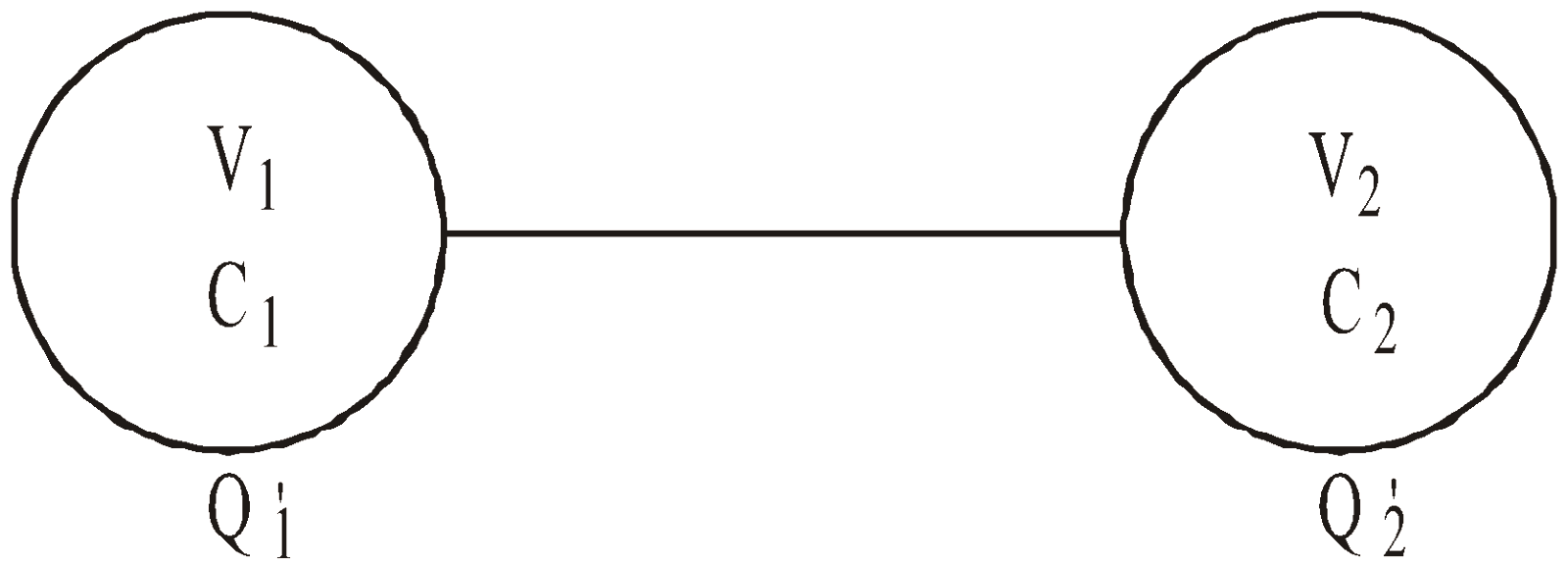
The common potential after sharing of charges,
The charges after sharing on two conductors will be
There is a loss of energy during sharing, converted to heat given by

PARALLEL PLATE CAPACITOR
It consists of two parallel metallic plates of any shape, each of area A and at a distance d apart.
The capacitance of the capacitor is given by 
EFFECT OF DIELECTRIC ON CAPACITANCE
When a dielectric slab is placed between the plates of a parallel plate capacitor, the charge induced on its plates due to polarisation of dielectric is 
where K = dielectric constant.
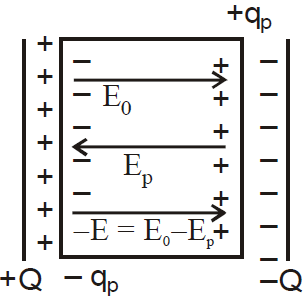
When an electric field is applied across a dielectric, induced charges appear on the surface of dielectric which is shown in the above figure. These induced charges produce their own field which acts in the opposite direction of the applied field. Hence, total field is reduced, i.e., E0 = Ep – E where E0 is the applied field, Ep is the induced field and E is the resultant field.
E is given by , where K is the dielectric constant.
, where K is the dielectric constant.
If medium between the plates is having a dielectric of dielectric constant K then the capacitance is given 
If the space between the plates is partly filled with dielectric then the capacitance of the capacitor will be given by,
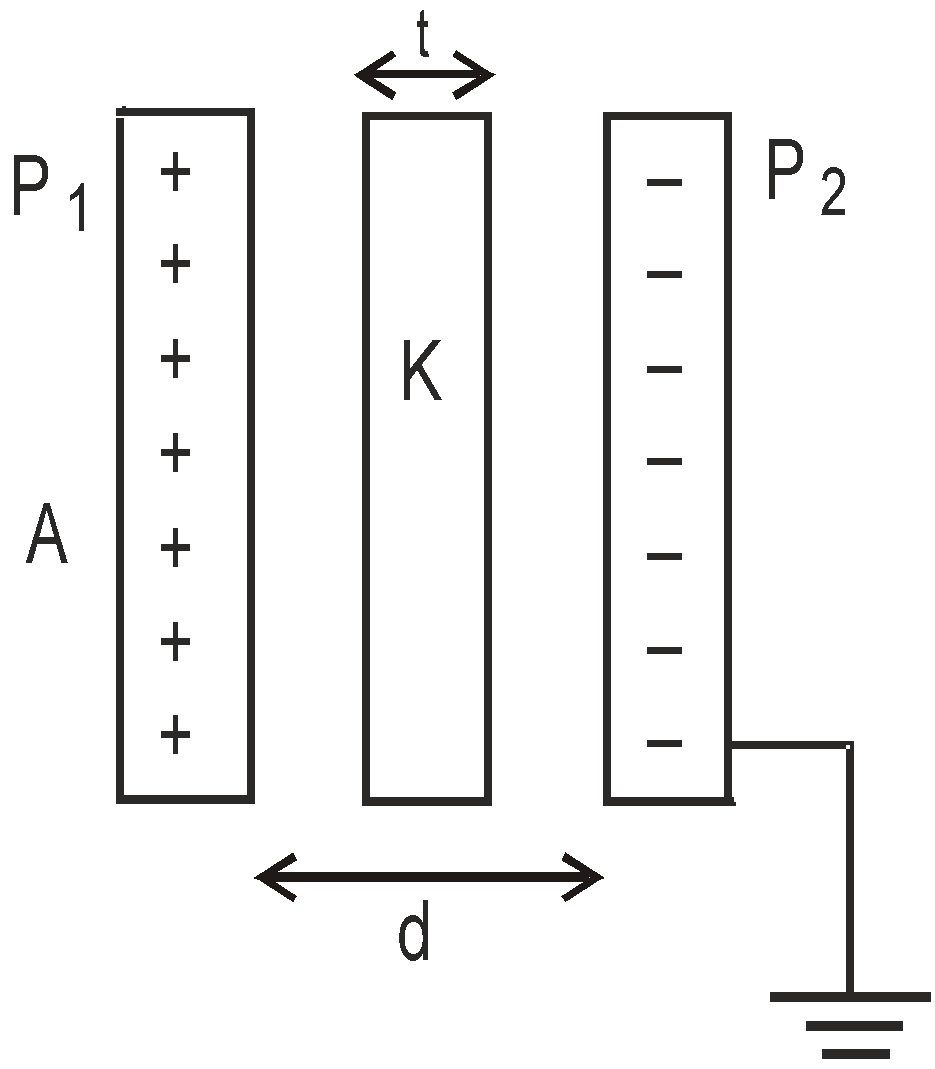
 ,
, where t is the thickness of the dielectric with dielectric constant K.
KEEP IN MEMORY
- The unit farad is quite a big unit for practical purposes. Even the capacitance of a huge body like earth is 711 μF.
- A capacitor is a device which stores charges and produces electricity whenever required.
- If the two plates of a capacitor is connected with a conducting wire, sparking takes place which shows that electrical energy is converted into heat and light energy.
- A capacitor allows A.C. but doesn’t allow D.C. to pass through it.
- The capacitance of a capacitor increases with insertion of a dielectric between its plates and decreases with increase in the separation between the plates.
- The capacitance of a capacitor increases K times if a medium of dielectric constant K is inserted between its plates.
- The energy of a capacitor for a particular separation between the plates is the amount of work done in separating the two plates to that separation if they are made to touch to each other.
- The loss of energy when the two charged conductors are connected by a wire doesn’t depend on the length of the wire.
SPHERICAL CAPACITOR
It consists of two concentric spherical conductors of radii R1 and R2. The space between two conductors is filled by a dielectric of dielectric constant K.
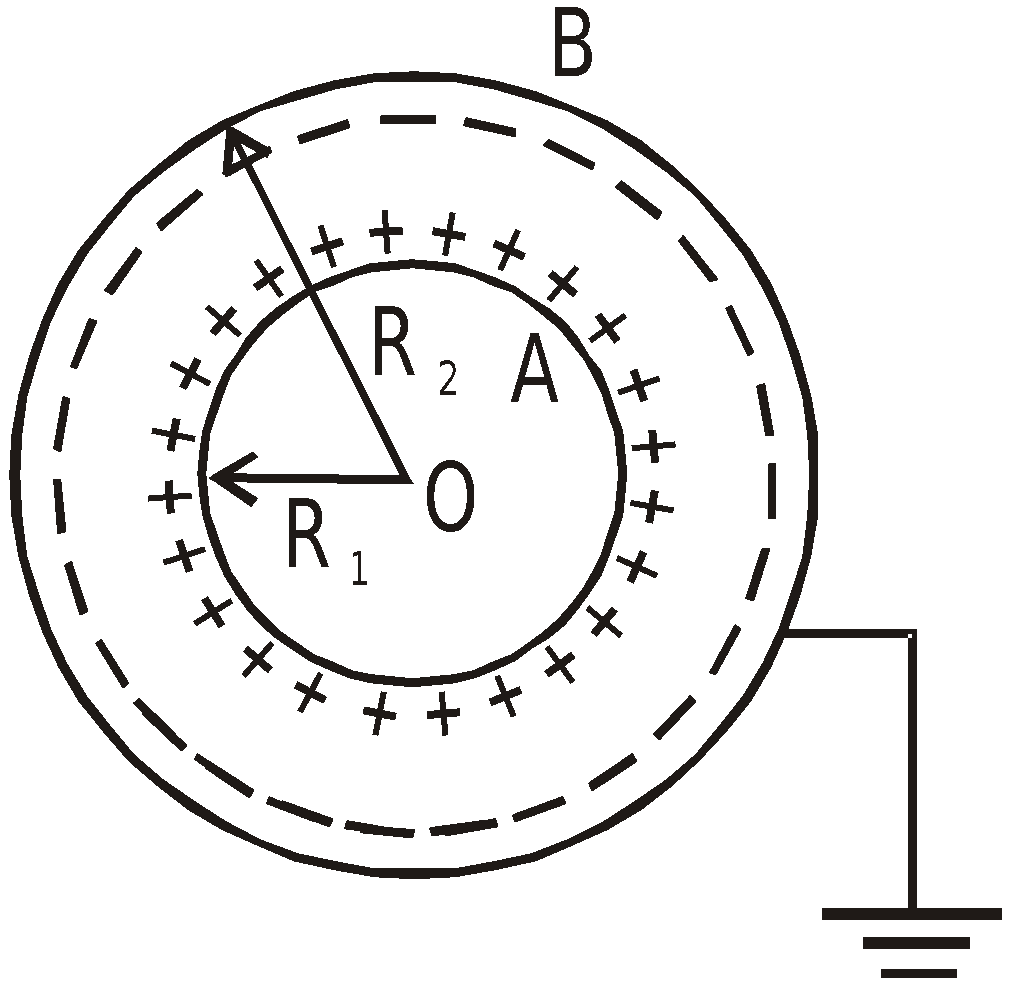
- When outer conductor is earthed,
Capacitance of spherical capacitor,
- When inner sphere is earthed,
This is because the combination behaves as two capacitors in parallel, one is a capacitor formed by two concentric spherical shells and the other is an isolated spherical shell of radius R2.
CYLINDRICAL CAPACITOR
It consists of two-coaxial cylindrical conductors of radii R1 and R2, the outer surface of outer conductor being earthed. The space between the two is filled with a dielectric of dielectric constant K.
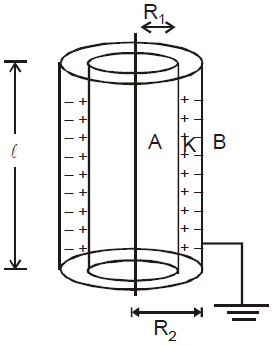
The capacitance of cylindrical condenser of length l
 (without dielectric)
(without dielectric) (with dielectric)
(with dielectric)COMBINATION OF CAPACITORS
SERIES COMBINATION
- In this combination, the positive plate of one capacitor is connected to the negative plate of the other.
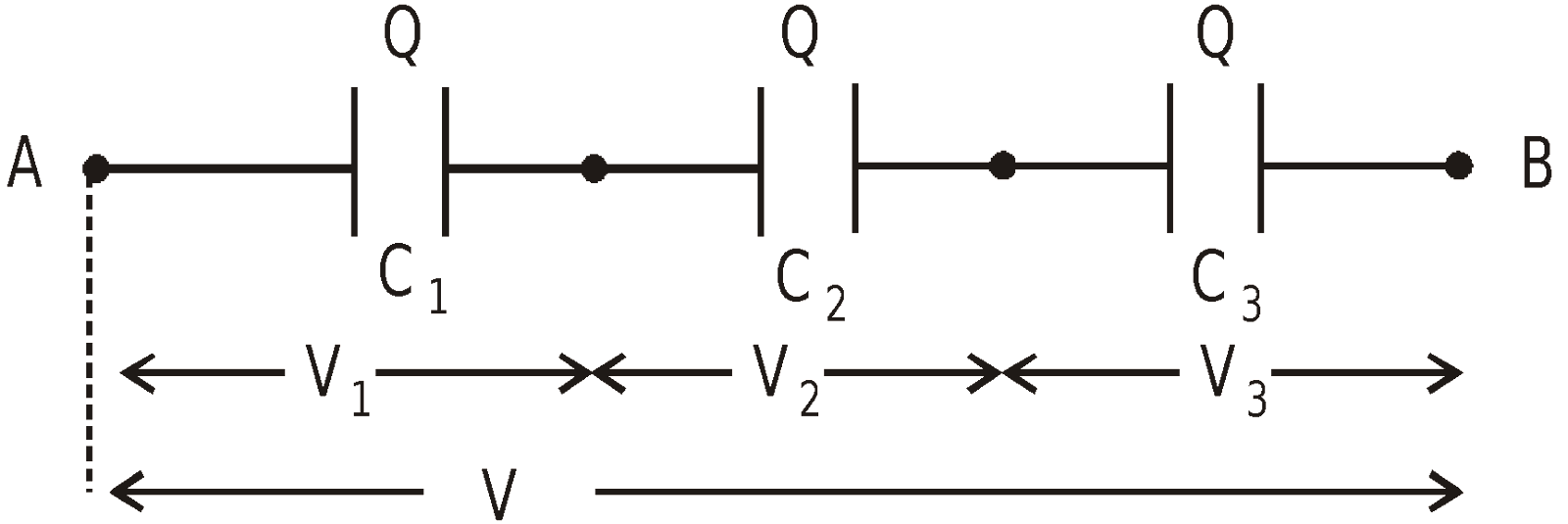
- The charges of individual capacitor are equal.
- The potential difference is shared by the capacitors in the inverse ratio of their capacities
i.e. Q = C1V1 = C2 V2 = C3 V3
Hence V = V1 + V2 + V3
- The equivalent capacitance (C) between A and B is
PARALLEL COMBINATION
- In this arrangement, +ve plates of all the condensers are connected to one point and negative plates of all the condensers are connected to the other point.
- The Potential difference across the individual capacitor is same.
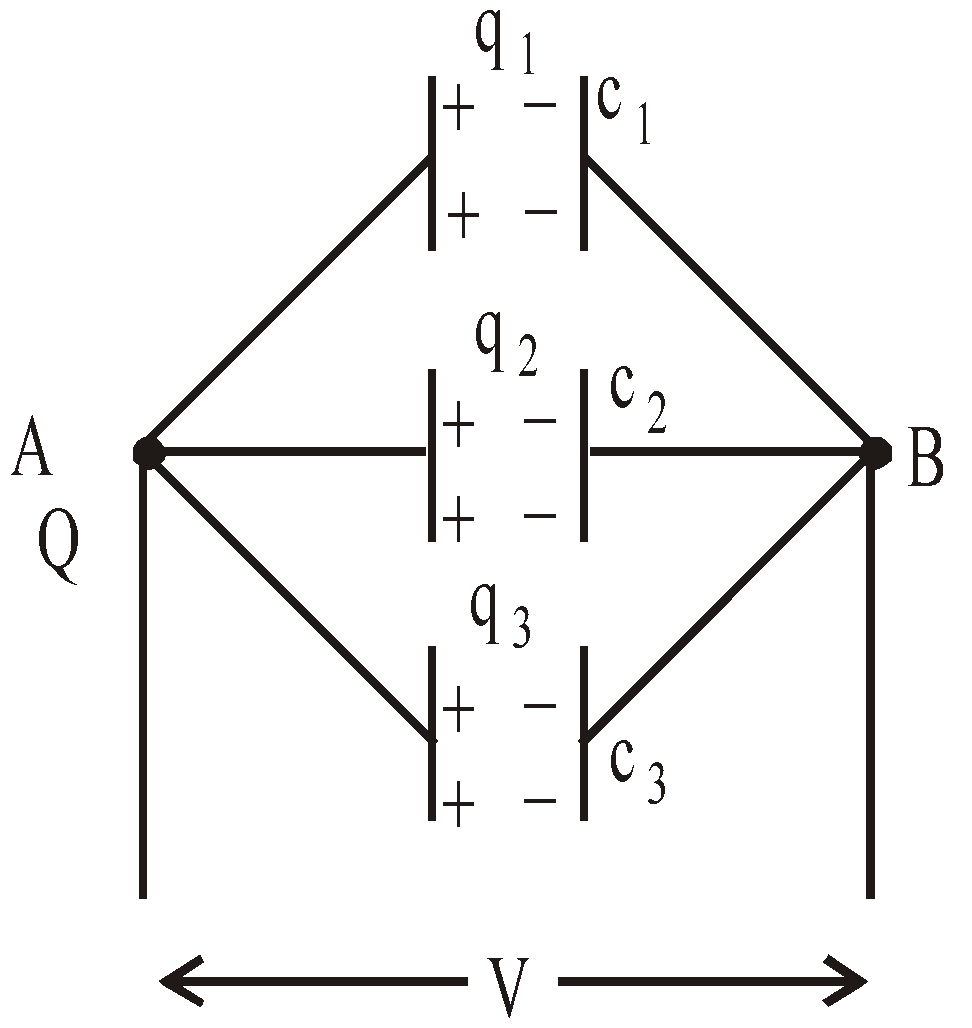
- The total charge shared by the individual capacitor is in direct ratio of their capacities
i.e.
Hence, Q = q1 + q2 + q3
- The equivalent capacitance between a and b is ceq = c1 + c2 + c3 + ……..+ cn
KEEP IN MEMORY
- The capacitance of a parallel plate capacitor having a number of slabs of thickness t1, t2, t3 …. and dielectric constant K1, K2, K3 …. respectively between the plates is

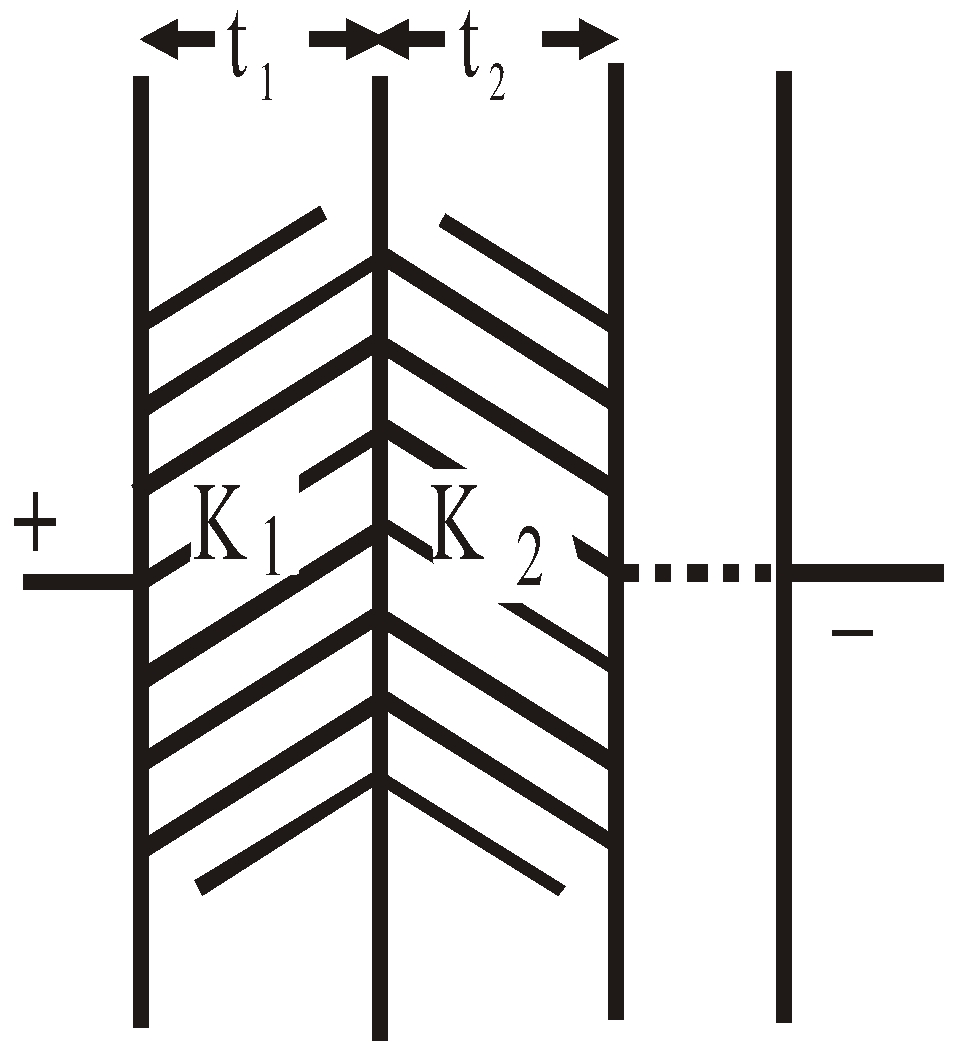
- When a number of dielectric slabs of same thickness (d) and different areas of cross-section A1, A2, A3 … having dielectric constants K1, K2, K3, …. respectively are placed between the plates of a parallel plate capacitor then the capacitance is given by

- When five capacitors are connected in wheatstone bridge arrangement as shown, such that
 , the bridge is balanced and C5 becomes ineffective. No charge is stored on C5. Therefore C1, C2 and C3, C4 are in series. The two series combinations are in parallel between A and C. Hence equivalent capacitance can be calculated.
, the bridge is balanced and C5 becomes ineffective. No charge is stored on C5. Therefore C1, C2 and C3, C4 are in series. The two series combinations are in parallel between A and C. Hence equivalent capacitance can be calculated.
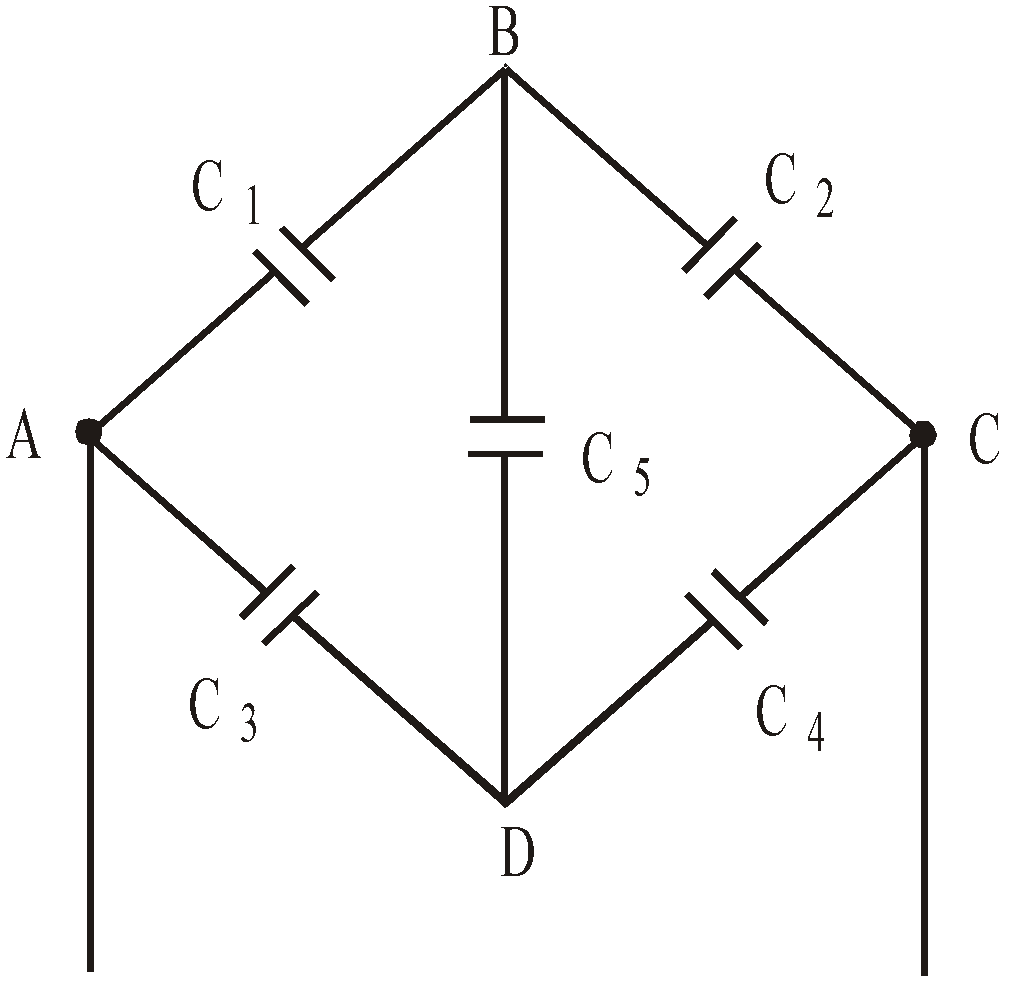
RELATION BETWEEN THREE ELECTRIC VECTORS
If an electric field E is applied across a parallel plate capacitor filled with a dielectric of dielectric constant K (or permittivity ε), then
Polarisation P = induced charge per unit area (opposite to free charge) = 
Electric displacement D = εE = εo E + P
i.e. Polarisation P = (ε – εo) E = (Kεo – εo) E
Electric susceptibility, 
Relation between dielectric constant K and electric susceptibility χe
EFFECT OF FILLING DIELECTRIC WITH BATTERY CONNECTED
When there is no dielectric
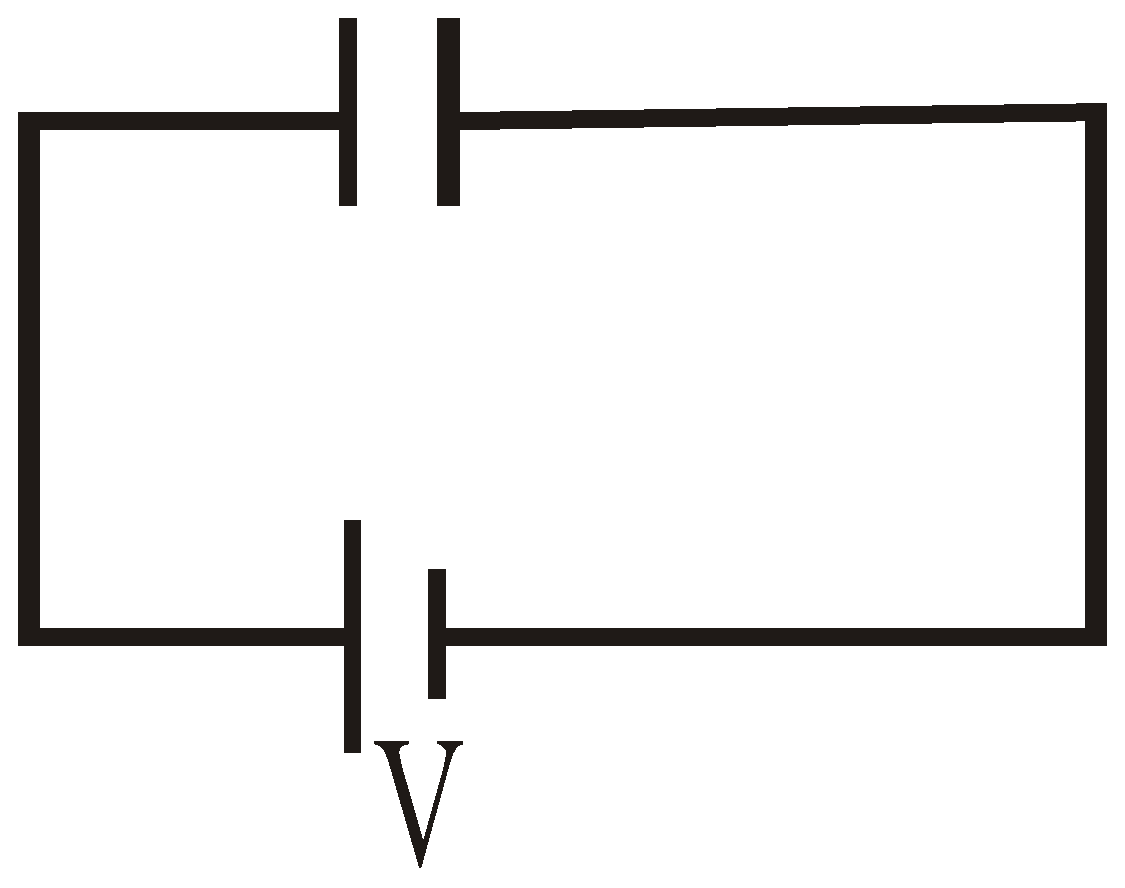
Capacitance 
Potential difference between the plates V
Charge on a plate Q = CV
Energy 
Electric field 
When dielectric is inserted
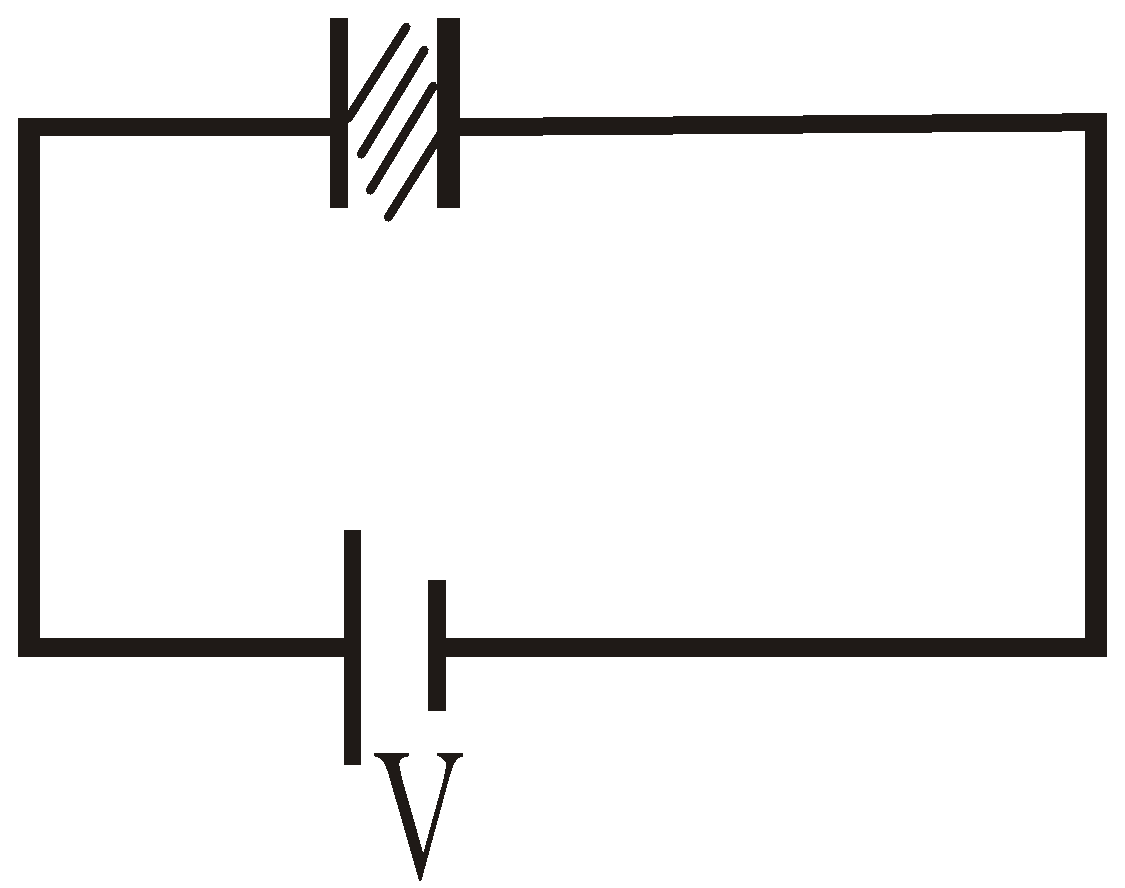
Q = K C0 V = KQ0
EFFECT OF FILLING A DIELECTRIC IN A CAPACITOR AFTER DISCONNECTION OF BATTERY
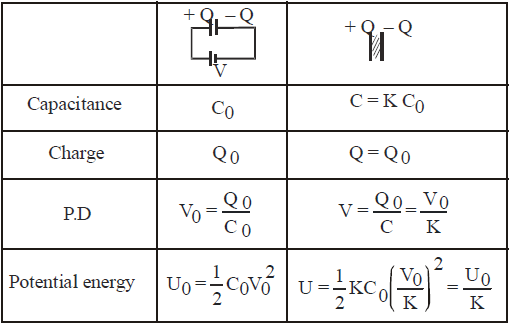
CHARGING AND DISCHARGING A CAPACITOR
CHARGING A CAPACITOR
When an uncharged capacitor is connected across a source of constant potential difference such as a cell, it takes a finite time to get fully charged, although this time interval may be small. This time-interval depends on the capacity of the capacitor and the resistance in the circuit.
DURING THE PERIOD OF CHARGING
- The charge on the capacitor increases from ‘zero’ to the final steady charge.
- The potential difference developed across the capacitor opposes the constant potential difference of the source.
- The charge on the capacitor ‘grows’ only as long as the potential difference of source is greater than the potential difference across the capacitor. This transport of the charge from the source to the capacitor constitutes a transient current in the circuit.
- As the charge on the capacitor increases, more energy is stored in the capacitor.
- When the capacitor is fully charged, potential difference across the capacitor is equal to the potential difference of the source and the transient current tends to zero.
If V0 = constant potential difference of the source
R = pure resistance in the circuit
C = capacity of the capacitor
Q0 = final charge on the capacitor, when fully charged
q = charge on the capacitor at time ‘t’ from the starting of the charging
V = potential difference across the capacitor at time ‘t’
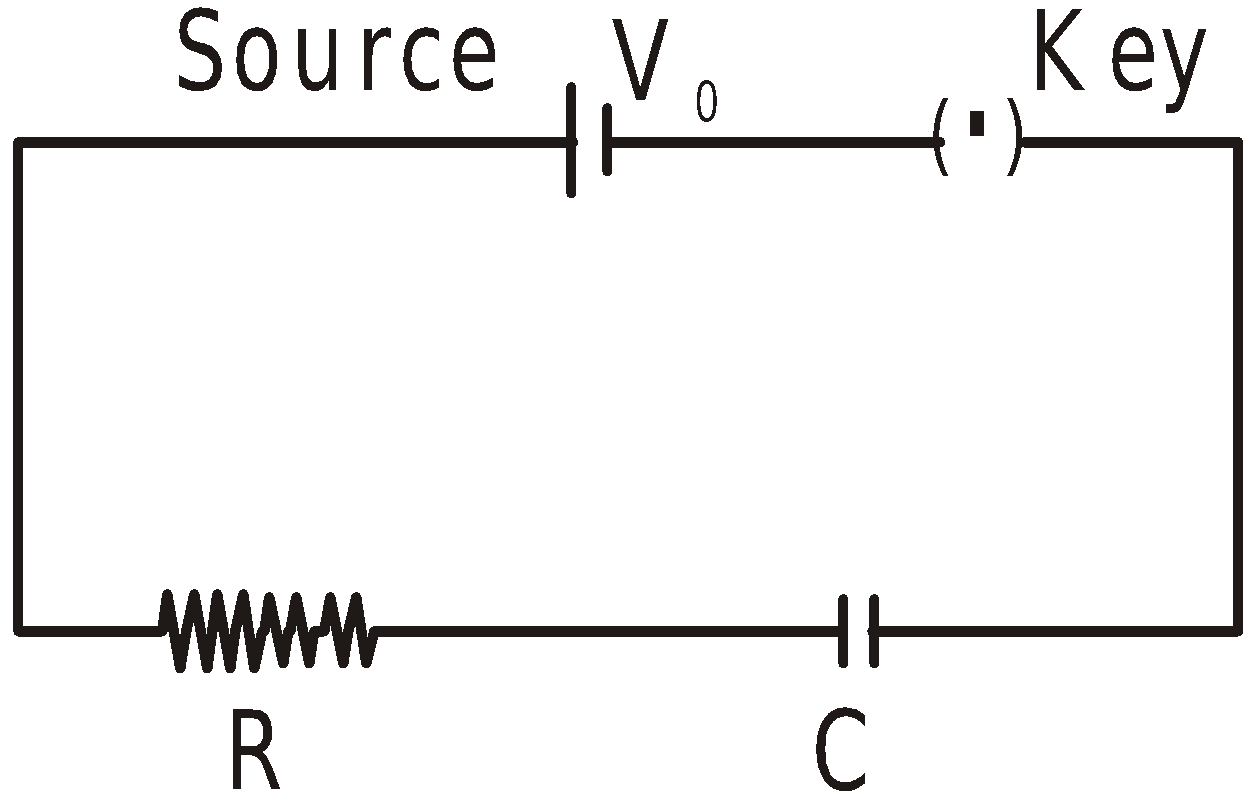
Then 
and i = current in the circuit at time ‘t’ = 
At time ‘t’ by Kirchhoff’s law
i.e.
Integrating and putting in the initial condition q = 0 at t = 0, we get

Special cases :
- At t = 0, q = 0.
- When t increases, q increases.
- As


- At t = CR [‘CR’ has dimensions of time]
This value of t = CR is called the ‘time constant’ of the (CR) circuit.
DISCHARGING OF A CAPACITOR
If after charging the capacitor, the source of constant potential difference is disconnected and the charged capacitor is shorted through a resistance ‘R’, then by Kirchhoff’s law, at time ‘t’ from the instant of shorting,
Putting,
- the initial condition, q = Q0 at t = 0 and
- the final condition, q = 0 at ,

the solution to the above equation is 
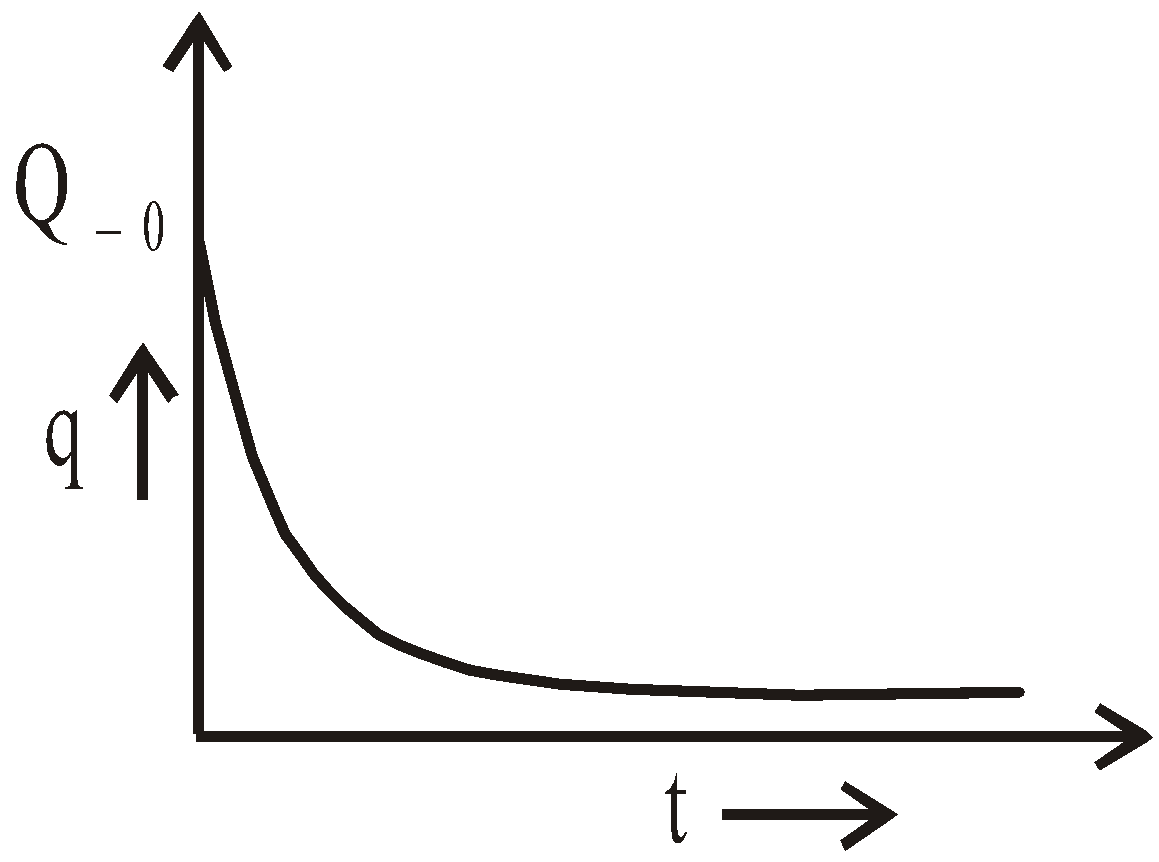

KEEP IN MEMORY
- If n small drops each having a charge q, capacity ‘C’ and potential V coalesce to form a big drop, then
- the charge on the big drop = nq
- capacity of big drop = n1/3 C
- potential of big drop = n2/3 V
- potential energy of big drop = n5/3 U
- surface density of charge on the big drop = n1/3 × surface density of charge on one small drop.
- Charged soap bubble : Four types of pressure act on a charged soap bubble.
- Pressure due to air outside the bubble PO, acting inwards.
- Pressure due to surface tension of soap solution PT, acting inwards.
- Pressure due to air inside the bubble, Pi, acting outwards.
- Electric pressure due to charging, Pe =
 , acting outwards.
, acting outwards.
In equilibrium, Pi + Pe = PO + PT
or, Pi – PO = PT – Pe
or, Pexcess = PT – Pe
∴
Where T = surface tension of soap solution,
σ = surface charge density of bubble.
If Pi = PO then Pi – PO = PT – Pe = 0 or PT = Pe

Hence for maintaining the equilibrium of charged soap bubble,


- Force of attraction between the plates of a parallel plate capacitor =

where, A = area of the plates of capacitor, K = dielectric constant of the medium filled between the plates.
In terms of electric field, the force of attraction 
- Uses of capacitor :
- In LC oscillators
- As filter circuits
- Tuner circuit in radio etc.
- The total energy stored in an array of capacitors (in series or in parallel) is the sum of the individual energies stored in each capacitor.
COMBINATION OF CAPACITOR : EQUIVALENT CAPACITANCE
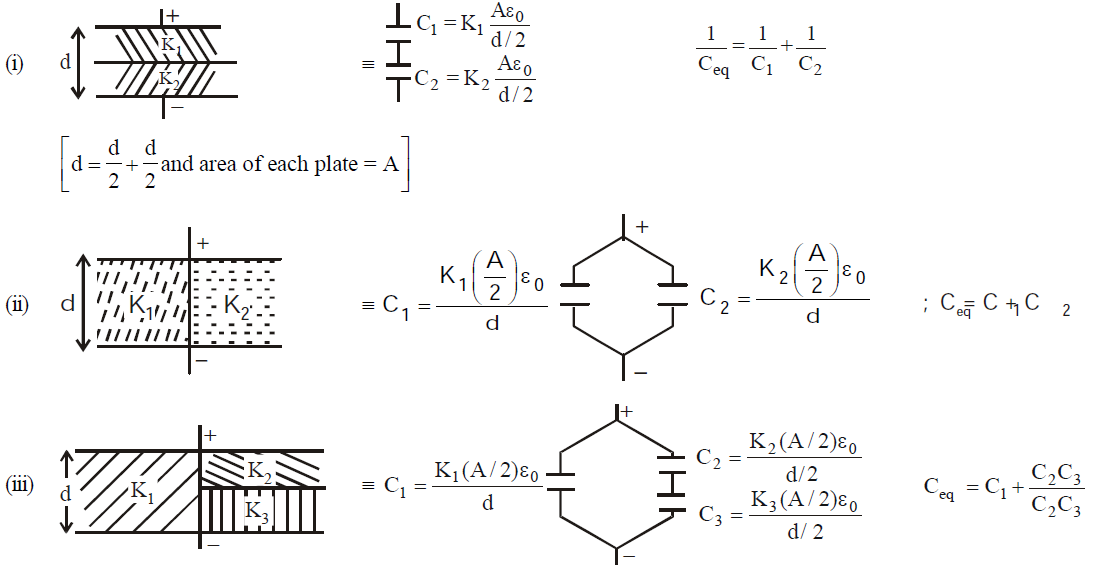
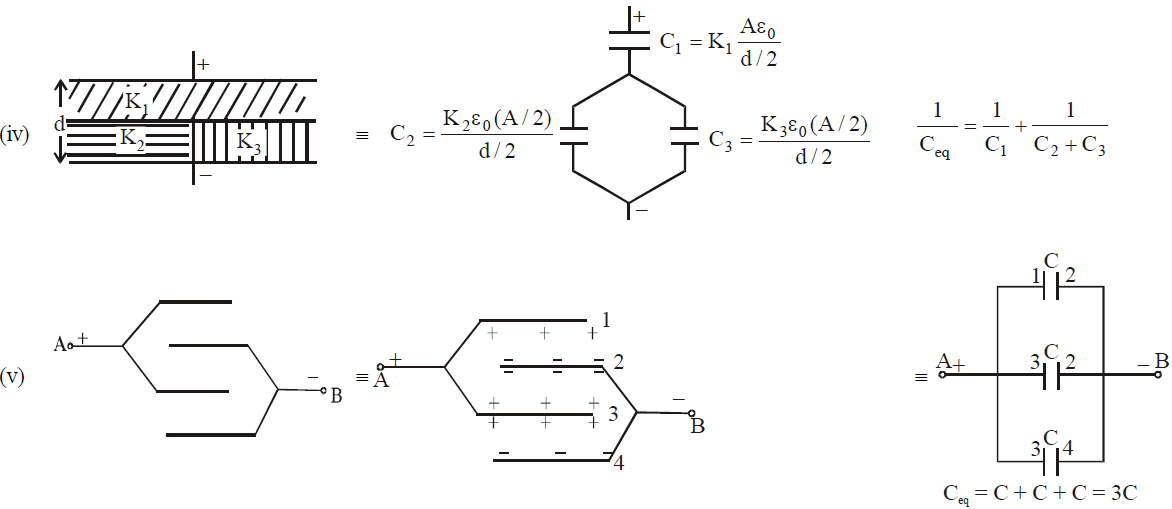
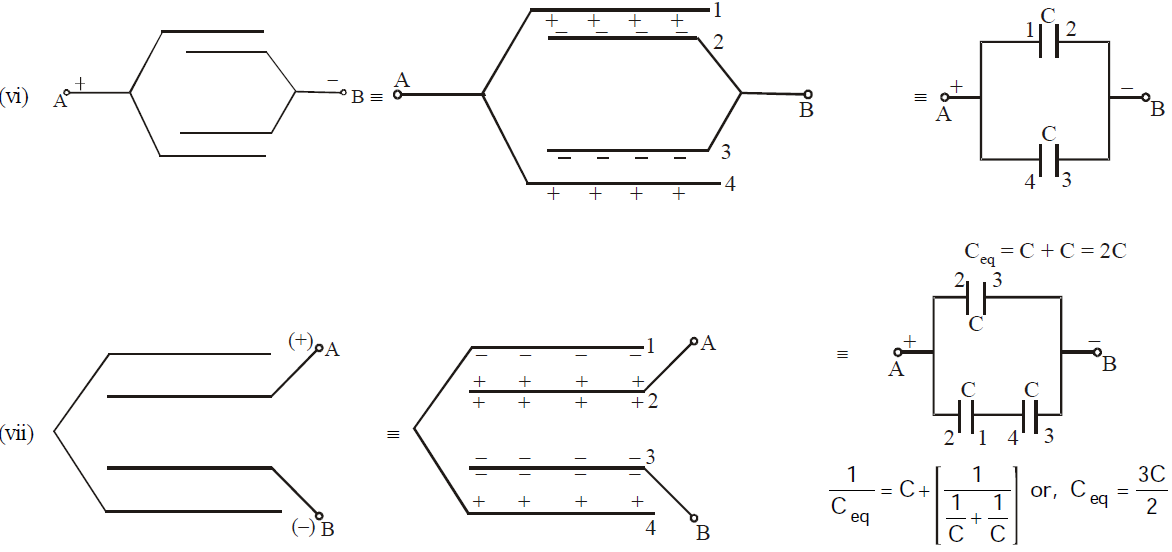
SOME METHODS OF FINDING EQUIVALENT CAPACITANCE
METHOD 1 : Successive Reduction
This method is applicable only when the capacitor can be clearly identified as in series or in parallel.
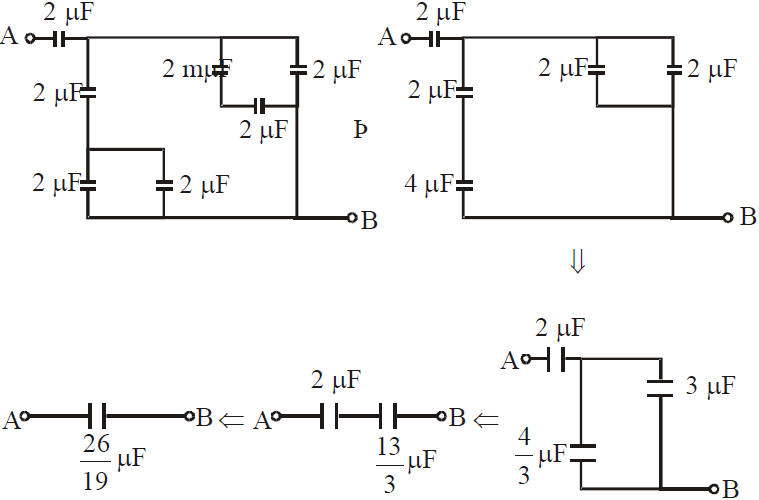
METHOD 2 : Using Symmetry
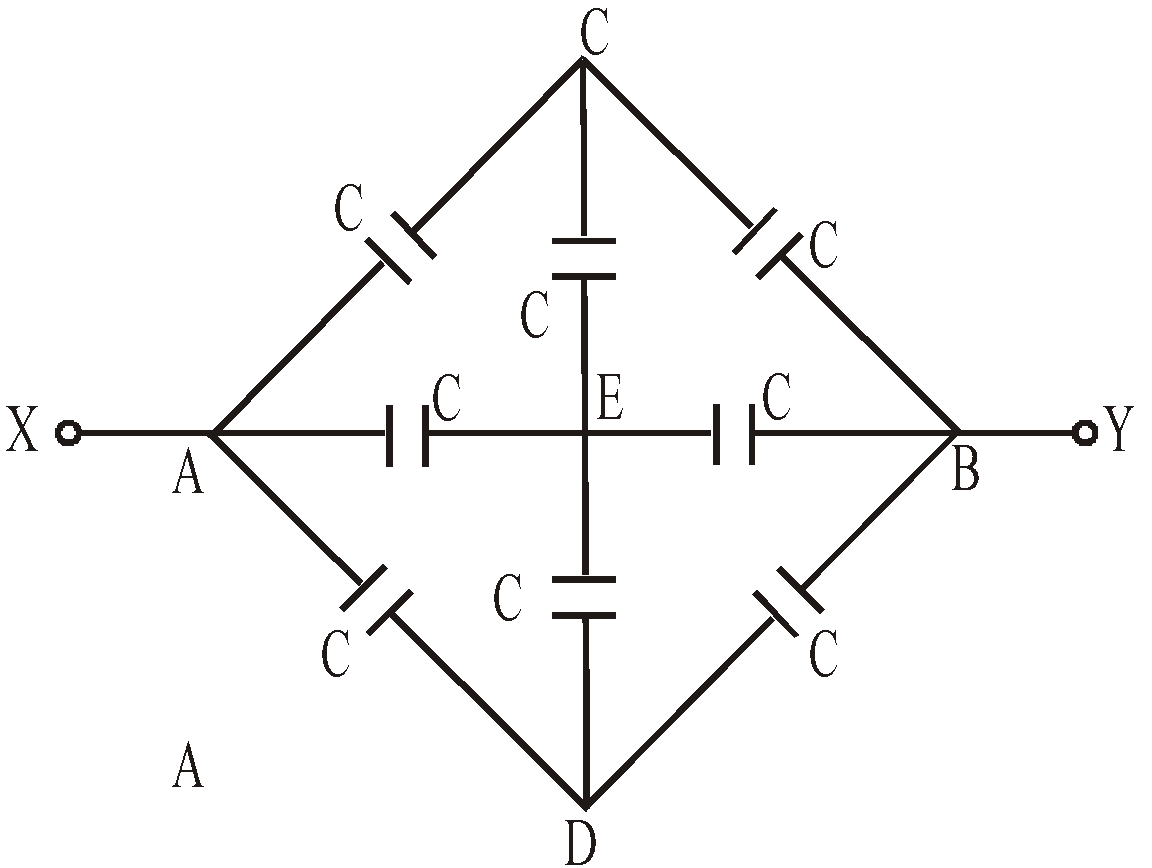
The above circuit is symmetrical about XAEBY axis. This is because the upper part of the circuit is mirror image of lower part.
Therefore VC = VE = VD. The circuit can be redrawn as
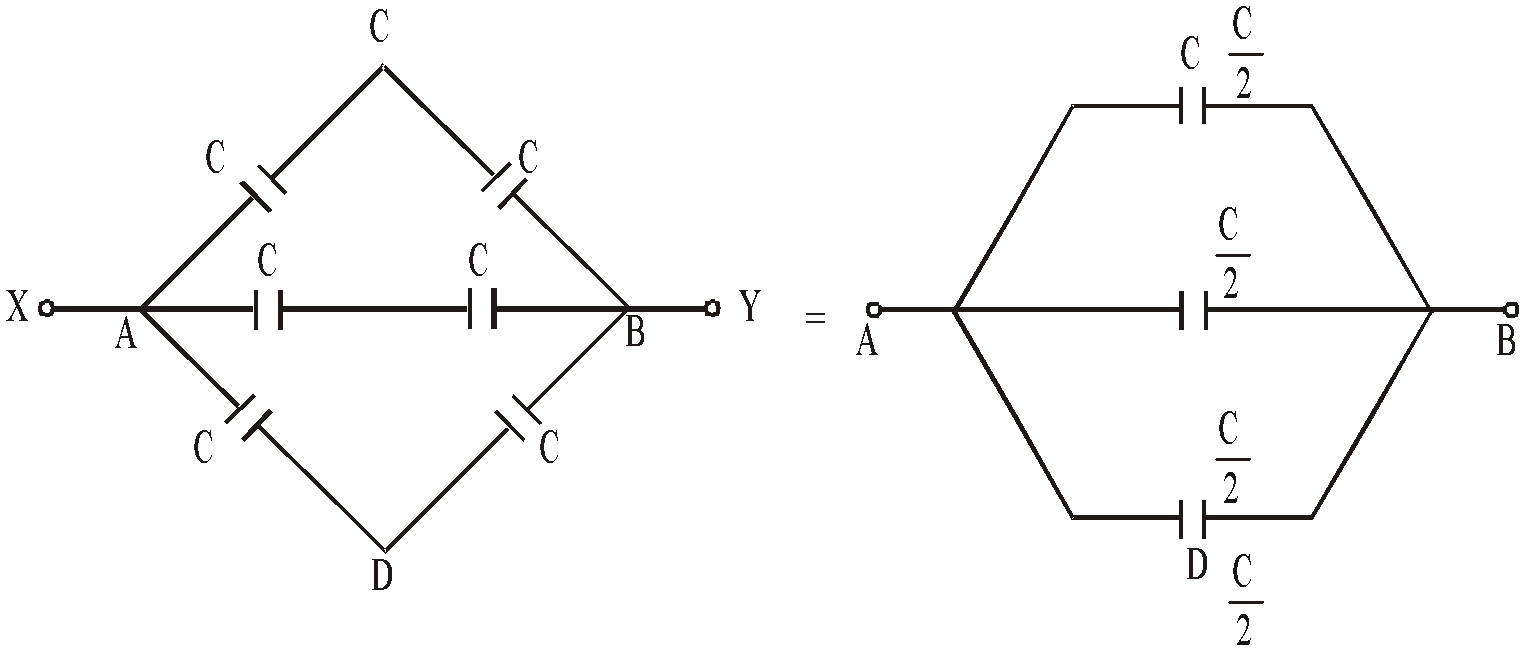

METHOD 3 : Wheatstone bridge
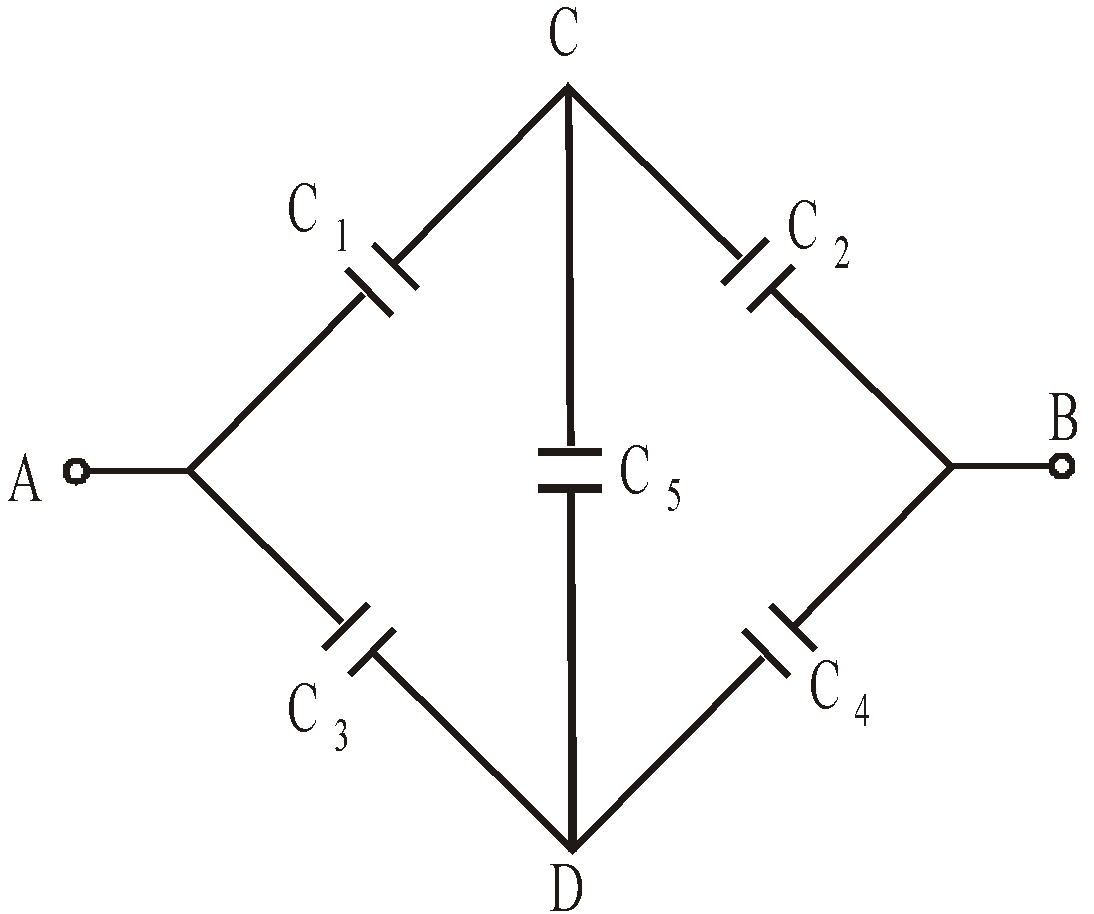
If  then the wheatstone bridge is balanced. In this case there will be no charge accumulation in C5 when battery is attached across A and B. Therefore the equivalent circuit is the capacitance C1 and C2 are in series. Similarly C3 and C4 is in series. Therefore the equivalent capacitance occurs between A and B is
then the wheatstone bridge is balanced. In this case there will be no charge accumulation in C5 when battery is attached across A and B. Therefore the equivalent circuit is the capacitance C1 and C2 are in series. Similarly C3 and C4 is in series. Therefore the equivalent capacitance occurs between A and B is
The other forms of wheatstone bridge are :

or
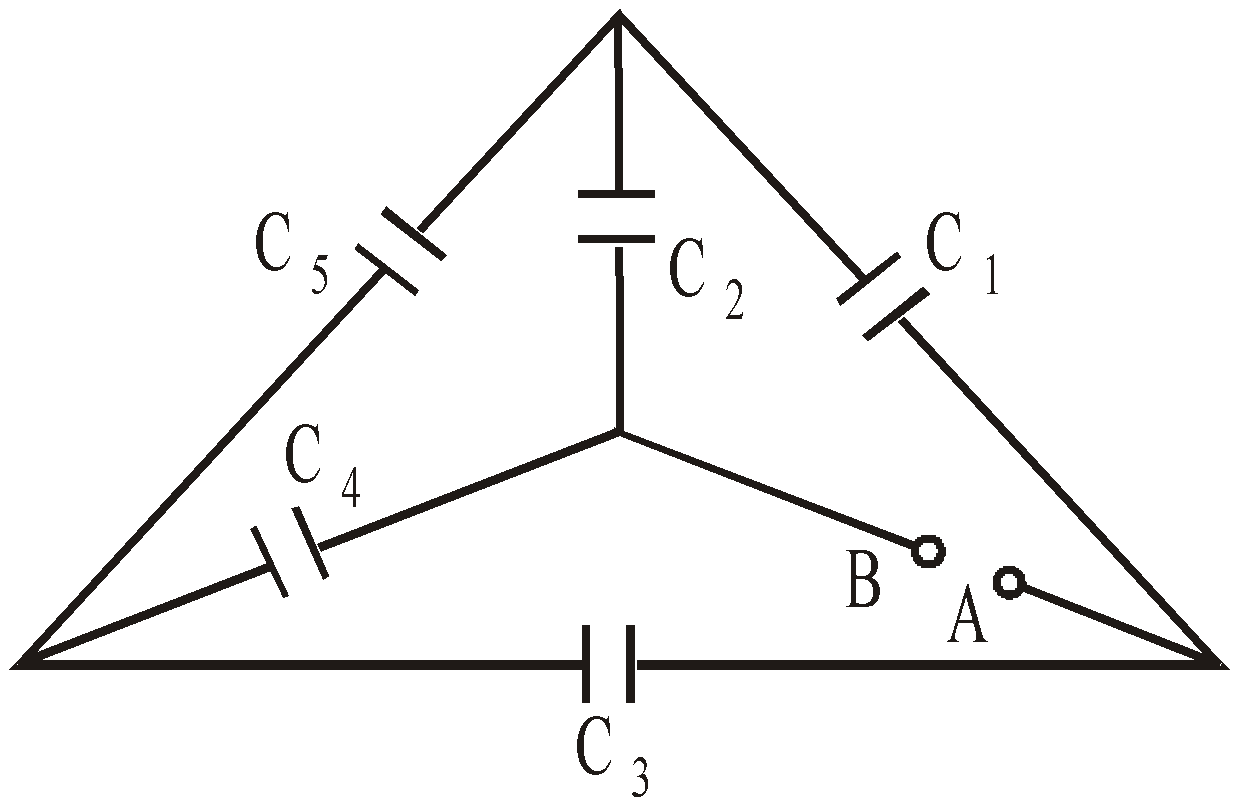
METHOD 4 : If none of the above method works, then we can use the method of Kirchhoff’s laws – junction law and loop law.
SHARP POINT ACTION (CORONA DISCHARGE)
When the electric field on a point on the surface of a conductor exceeds the electric strength of air, then the air becomes conducting and the surface of conductor loses charge. This action occurs usually at the sharp points of a conductor as here σ is high, thus creating high electric field. This phenomenon is also called corona discharge.
VAN DE GRAAF GENERATOR
R.J. Van de Graff in 1931 designed an electrostatic generator capable of generating very high potential of the order of 5 × 106 V, which was then made use of an accelerating charged particles so as to carry out nuclear reactions.
Principle : When a charged conductor is placed in contact with the inside of a hollow conductor, all of the charge of first conductor is transferred to the hollow conductor. i.e., the charge on hollow conductor or its potential can be increased by any limit by repeating that processes.
The basic fact of Van de Graaf generator is described in fig. (Charge is delivered continuously to a high voltage electrode on a moving belt of insulating material).
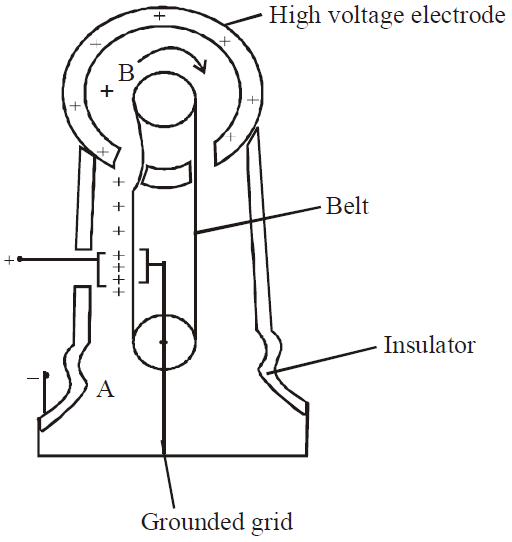
Schematic diagram of a Van de Graaf generator.
Charge is transferred to hollow conductor at the top by means of a rotating belt. The charge is deposited on the belt at point A and is transferred to hollow conductor at point B.
The high voltage electrode is a hollow conductor mounted on an insulating medium. The belt is charged at A by means of corona discharge between comb-like metallic needles and a grounded grid. The needles are maintained at a positive potential of typically 104 eV. The positive charge on the moving belt is transferred to the high voltage electrode by second comb of needles at B.
Since the electric field inside the hollow conductor is negligible, the positive charge on the belt easily transfers to the high- voltage electrode, regardless of its potential. We can increase the potential of the high voltage electrode until electrical discharge occur through the air. The “breakdown” voltage of air is about 3 × 10 6 V/m.
GRAVITATION
NEWTON’S UNIVERSAL LAW OF GRAVITATION
Gravitational force is an attractive force between any two point masses M1 and M2 separated by any distance r.
It is given by F = G 
where G is the universal gravitational constant.
Its value, G = 6.67 × 10–11 Nm2 kg–2
Dimensions of G are [M–1 L3 T–2]
- The gravitational force is the central force and follows inverse square law. It acts along the line joining the particles.
- Since the work done by the gravitational force is independent of the path followed and hence it is a conservative force.
- It is the weakest force in nature. It is 1038 times smaller than nuclear force and 1036 times smaller than electric force. Strongest force being nuclear force (for small range) followed by electric force.
- Gravitation is independent of the presence of other bodies around it.
ACCELERATION DUE TO GRAVITY (g)
The force of attraction exerted by earth on a body of mass m is the force of gravity.
So the force of gravity from Newton’s gravitational law is
where Me = mass of earth
r = distance of the body from the centre of earth.
The force of gravity can be written as F = mg ……(ii)
where g is called the acceleration due to gravity.
From the expression (i) and (ii), we get
If body is located at the surface of earth i.e., r = Re (radius of earth) then
 ……(iv)
……(iv)where ρ is the density of earth.
This is the relation between universal gravitational constant ‘G’ and acceleration due to gravity ‘g’.
CHANGE IN THE VALUE OF ACCELERATION DUE TO GRAVITY (g)
- Due to rotation or latitude of earth
Let us consider a particle P at rest on the surface of earth at a latitude φ.
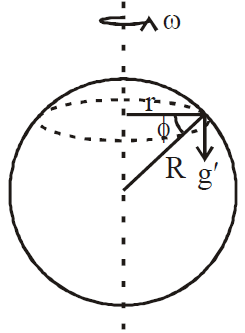
At poles φ = 90º, so g(φ) = g …(v)
At equator φ = 0º so g(φ) = g –ω2Re …(vi)
- Due to shape of earth
The shape of the earth is not perfectly spherical. It is flattened at poles. The polar radius is 21 km less than the equatorial radius. Hence acceleration due to gravity at poles is greater than at the equator.
gp = 9.83 ms–2 = value of g at poles
ge = 9.78 ms–2 = values of g at equator
i.e. gp > ge
- At a depth ‘d’ below the earth surface
The acceleration due to gravity at the surface of earth.
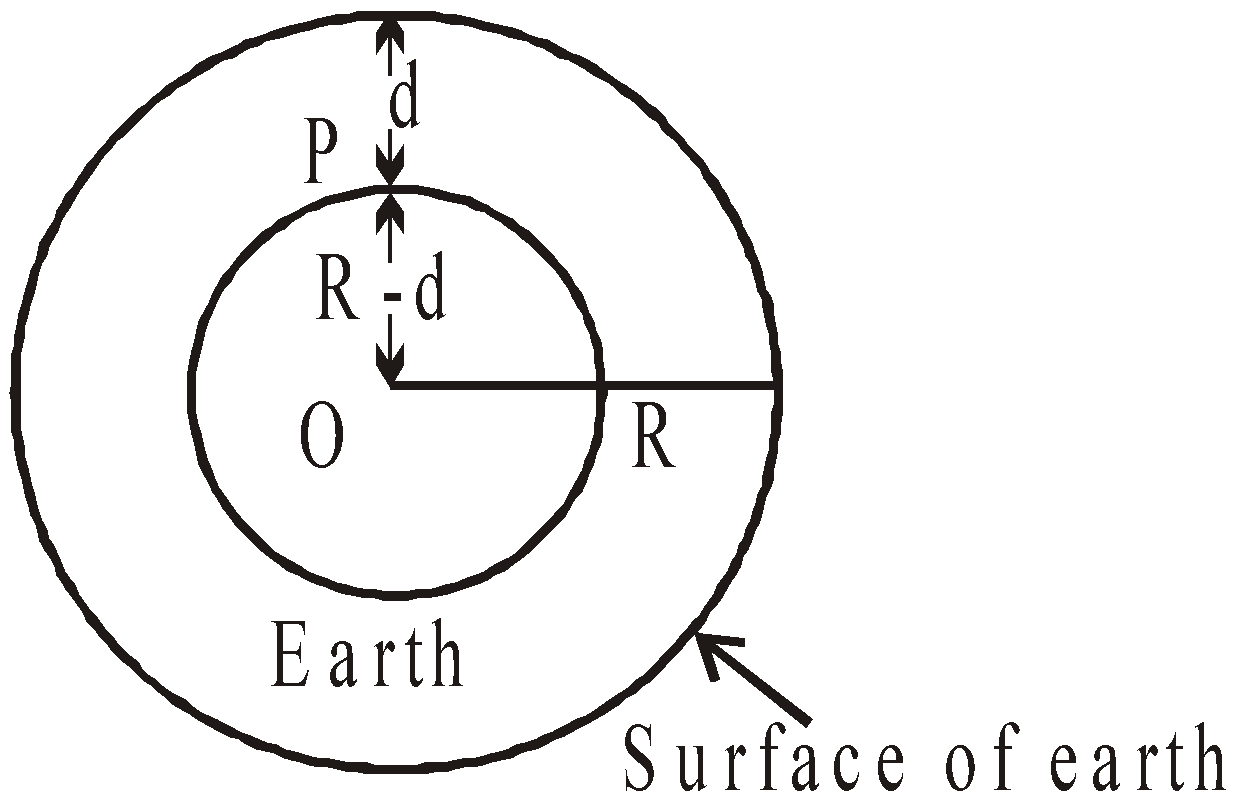
If a body is taken at a depth d below the earth surface, then the body is attracted by inner core of mass M’ of earth radius (Re– d). Then acceleration due to gravity at point P is

From eqns. (vii) and (viii) we have
The value of acceleration due to gravity at the centre of the earth is zero.
- At a height ‘h’ above the earth surface
The acceleration due to gravity at the surface of earth from expression (iv) is defined as
At a height h above the earth surface, the acceleration due to gravity is
 [from eqs. (ix) & (x)]
[from eqs. (ix) & (x)]If h << Re
KEEP IN MEMORY
- The value of the acceleration due to gravity on the moon is about one sixth of that on the earth and on the sun is about 27 times that on the earth.
- The value of g is minimum on the mercury, among all planets.
- For h<<R, the rate of decrease of the acceleration due to gravity with height is twice as compared to that with depth.
- The value of g increases with the increase in latitude. Its value at latitude θ is given by : gθ= g – Rω2 cos2θ.
- Rotation of the earth about its own axis is responsible for decrease in the value of g with latitude.
- The weight of the body varies along with the value of g (i.e. W = mg)
- Inertial mass and gravitational mass –
- Inertial mass (Mi) defined by Newton’s law of motion
Mi = F/a = 
(iff applied force on (Mi)1 and (Mi)2 is same.)
- Gravitational mass Mg defined by Newton’s law of gravitation
Mg = 
- If two spheres of same material, mass and radius are put in contact, the gravitational attraction between them is directly proportional to the fourth power of the radius.

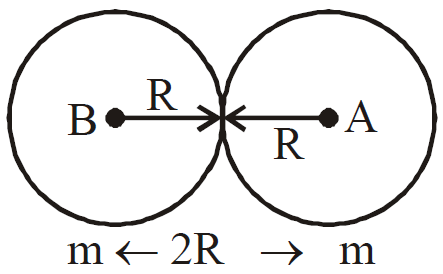
This system may be considered to be made up of two mass each separated by 2R distance.
- If the earth stops rotating about its axis, the value of g at the equator will increase by about 0.35%, but that at the poles will remain unchanged.
If the earth starts rotating at the angular speed of about 17 times the present value, there will be weightlessness on equator, but g at the poles will remain unchanged. In such a case, the duration of the day will be about 84 min.
- If the radius of planet decreases by n%, keeping the mass unchanged, the acceleration due to gravity on its surface increases by 2n%. i.e.,

- If the mass of the planet increases by m% keeping the radius constant, the acceleration due to gravity on its surface increases by m% i.e.,
 where R = constant.
where R = constant. - If the density of planet decreases by ρ% keeping the radius constant, the acceleration due to gravity decreases by ρ%.
- If the radius of the planet decreases by r% keeping the density constant, the acceleration due to gravity decreases by r%.
GRAVITATIONAL FIELD
(or Gravitational Field Intensity)
The region or space around a body in which its gravitational influence is experienced by other bodies is the gravitational field of that body.
The gravitational field strength Eg, produced by a mass M at any point P is defined as the force exerted on the unit mass placed at that point P. Then
where m = test mass
r = distance between M and m
The direction of Eg always points towards the mass producing it.
The gravitational field can be represented by gravitational lines of force.
The S.I unit of Eg is newton/kg. Its dimensions are [M0LT–2].
GRAVITATIONAL INTENSITY (Eg) FOR SPHERICAL SHELL
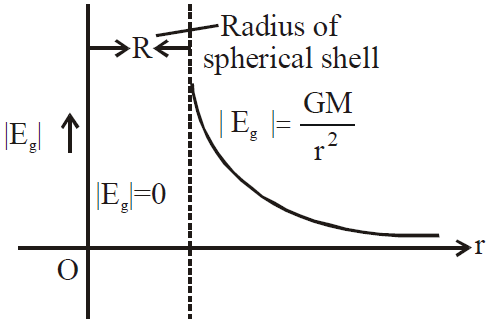
- |Eg|= 0 at points inside the spherical shell (i.e. r < R)
 at the surface of shell (i.e. r = R)
at the surface of shell (i.e. r = R) for outside the spherical shell (r >R)
for outside the spherical shell (r >R)
It is clear that as r increases, Eg decreases.
GRAVITATIONAL INTENSITY FOR SOLID SPHERE
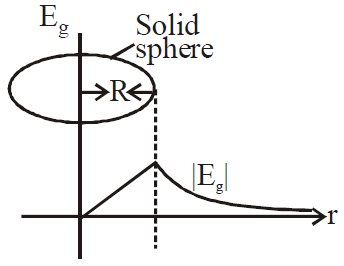
 for points inside the solid sphere (r<R)
for points inside the solid sphere (r<R)  At the surface of solid sphere (r = R)
At the surface of solid sphere (r = R)  Outside the solid sphere (r > R)
Outside the solid sphere (r > R)
GRAVITATIONAL POTENTIAL
Gravitational potential at any point is the work done by gravitational force in carrying a body of unit mass from infinity to that point in gravitational influence of source. i.e., 
where r is the distance of point from source mass M.
The S.I. unit of V is joule/kg. Its dimensions are [M0L2T–2]. It is a scalar quantity.
GRAVITATIONAL POTENTIAL AT THE EARTH SURFACE
GRAVITATIONAL POTENTIAL DUE TO A UNIFORM RING AT A POINT ON ITS AXIS


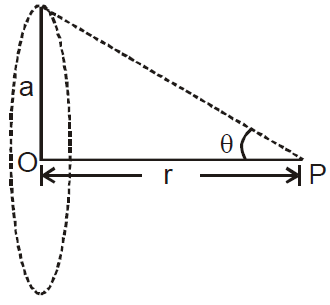
GRAVITATIONAL POTENTIAL DUE TO A UNIFORM THIN SPHERICAL SHELL
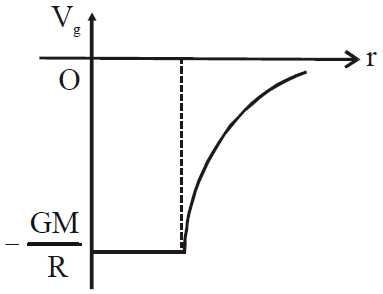
- at a point outside the shell,
 (r > R)
(r > R) - at a point inside the shell,
 (r < R)
(r < R)
where R = radius of spherical shell.
Potential due to a uniform spherical shell is constant throughout the cavity of the shell.
GRAVITATIONAL POTENTIAL DUE TO A UNIFORM SOLID SPHERE
- at an external point
 (r≥ R)
(r≥ R)
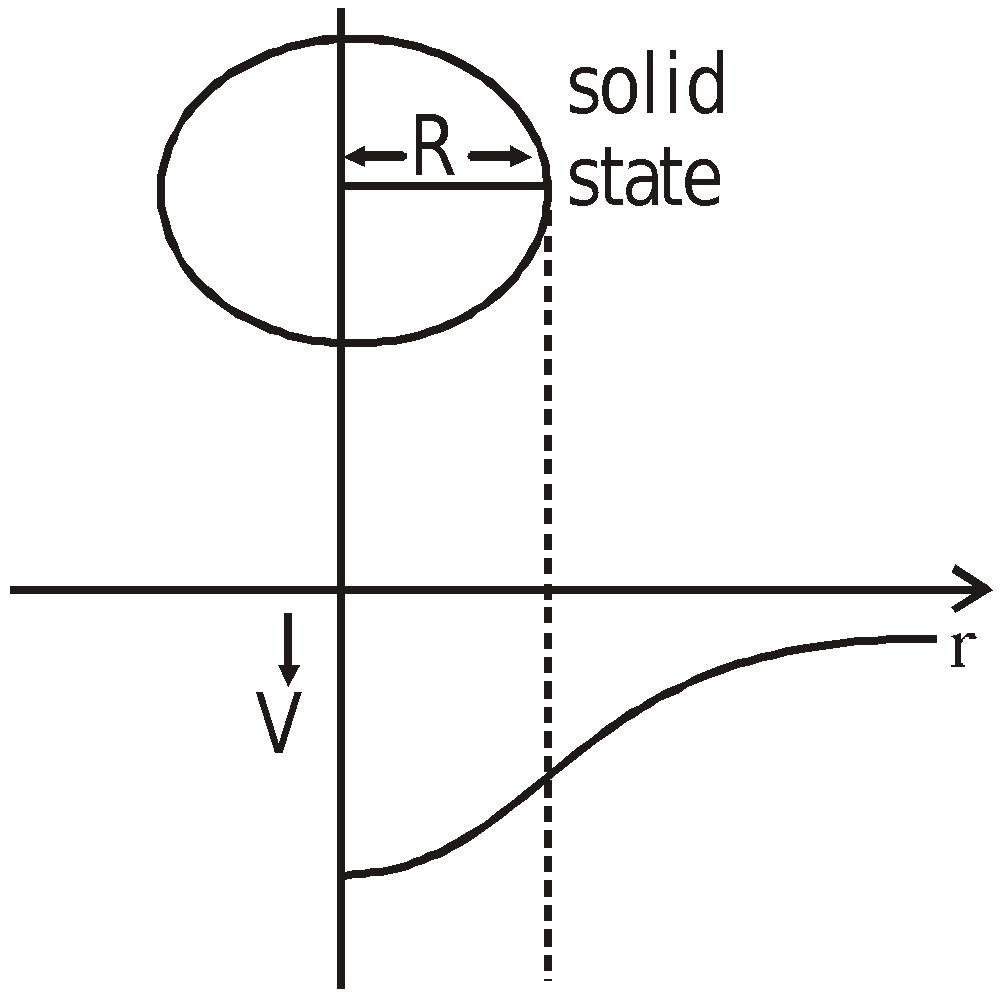
- at an internal point
 (r < R)
(r < R)
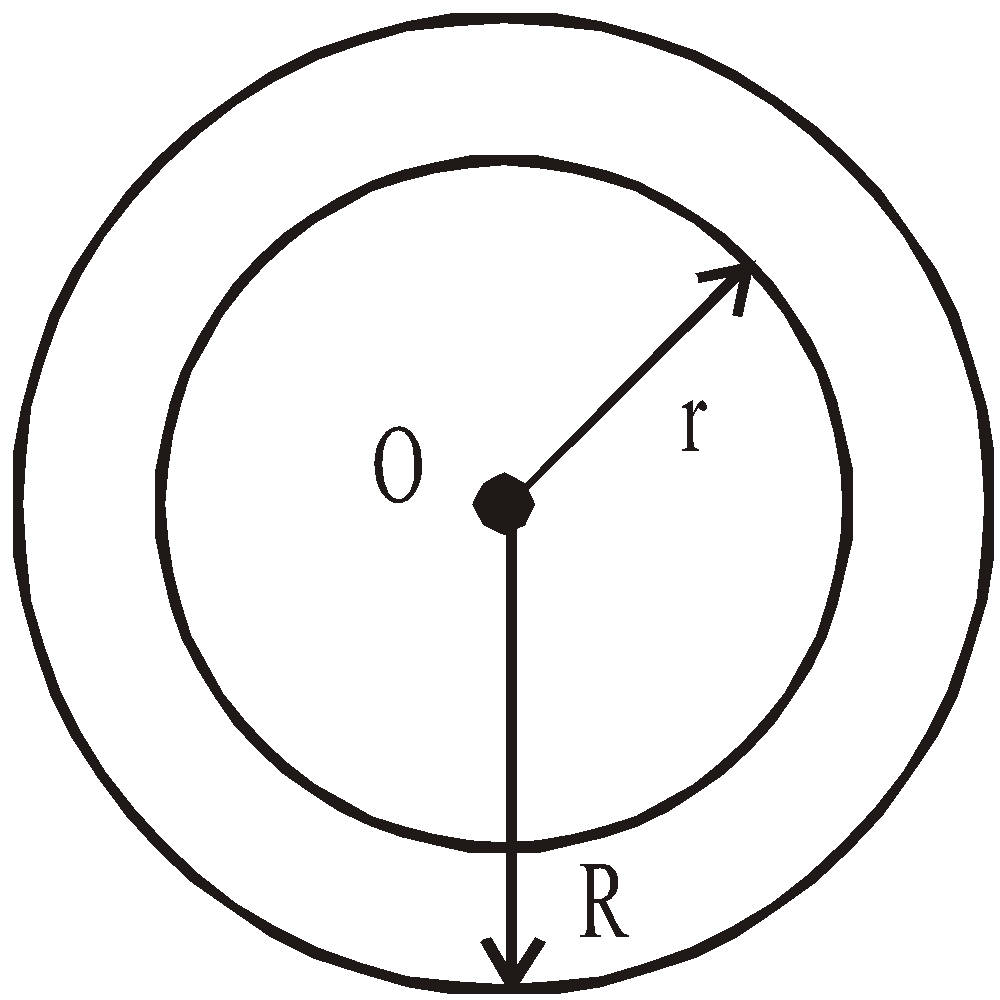
- Potential at the centre of solid sphere is

GRAVITATIONAL POTENTIAL ENERGY
Let Vg be the gravitational potential at a point. If we place a mass m at that point, then we say that the gravitational potential energy possessed by the mass is
We can also therefore say that the gravitational potential energy of a system containing two masses m1 and m2 placed such that the centre to centre distance between them is r then
This formula is valid taking into consideration the fact that we have taken the gravitational potential of few at infinity. Please remember that unless otherwise stated it is understood that the gravitational potential is taken to be zero at infinity.
Relation between gravitational potential energy and gravitational potential
Gravitational potential energy = gravitational potential × mass
KEEP IN MEMORY
- The gravitational potential energy of a mass m at a point above the surface of the earth at a height h is given by
 . The –ve sign shows that if h increases, the gravitational PE decreases and becomes zero at infinity.
. The –ve sign shows that if h increases, the gravitational PE decreases and becomes zero at infinity. - If we take reference level to be at the surface of earth (not at infinity) i.e., we assume that the gravitational P.E of a mass m is zero at the surface of earth, then the gravitational potential energy at a height h above the surface of earth is (mgh), where h << Re (radius of earth)
- The gravitational P.E of mass m on the earth’s surface is

If we assume that gravitational P.E of mass m is zero at infinity i.e., we take reference level at infinity then P.E.of any mass m at a height h above the earth surface
So work done against the gravitational force, when the particle is taken from surface of earth to a height h above the earth surface
Work done = change in potential energy
⇒ Uh–Ug = 

 (if h<<R)
(if h<<R)
So, work done = mgh is stored in the particle as particle potential energy, when kept at height ‘h’.
SATELLITES
A satellite is any body revolving around a large body under the gravitational influence of the latter.
The period of motion T of an artificial satellite of earth at a distance h above the surface of the earth is given by,
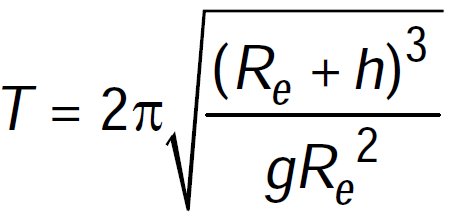
where, Re = radius of the earth
where, g = acceleration due to gravity on the surface of the earth.
If Re > > h, then  ; Re = 6.4 × 106 m ; g = 9.8 ms–2
; Re = 6.4 × 106 m ; g = 9.8 ms–2
 ; Re = 6.4 × 106 m ; g = 9.8 ms–2
; Re = 6.4 × 106 m ; g = 9.8 ms–2i.e. 
Assuming Re + h = r, the distance of the satellite from the centre of the earth,
ORBITAL VELOCITY (V0 )
Let a satellite of mass m revolve around the earth in circular orbit of radius r with speed v0. The gravitational pull between satellite and earth provides the necessary centripetal force.
Centripetal force required for the motion = 
Gravitational force = 
 or
oror  ………. (1)
………. (1)
 ………. (1)
………. (1)or  [∵
[∵  and r = (R + h)]
and r = (R + h)]
 [∵
[∵ Orbital velocity, 

- Value of orbital velocity does not depend on the mass of the satellite.
- Around the earth the value of orbital velocity is 7.92 km/sec.
- Greater is the height of the satellite, smaller is the orbital velocity.
- The direction of orbital velocity is along the tangent to the path.
- The work done by the satellite in a complete orbit is zero.
ANGULAR MOMENTUM (L)
For satellite motion, angular momentum will be given by

i.e., L = [m2GMr]1/2
Angular momentum of a satellite depends on both, the mass of orbiting and central body. It also depends on the radius of the orbit.
ENERGY OF A SATELLITE
Total energy of satellite revolving in an orbit of radius r around the earth can be calculated as follows :
- The gravitational potential energy of a satellite of mass m
 , where r is the radius of the orbit.
, where r is the radius of the orbit. - Kinetic energy of the satellite

- So, total energy of the satellite

The negative sign shows that satellite cannot leave the orbit itself. It requires an energy equal to , which is called Binding Energy (B.E.) of satellite.
, which is called Binding Energy (B.E.) of satellite.
- Total energy of a satellite at a height equal to the radius of the earth

GEO-STATIONARY SATELLITE
A satellite which appears to be stationary for a person on the surface of the earth is called geostationary satellite.
It is also known as parking satellite or synchronous satellite.
- The orbit of the satellite must be circular and in the equatorial plane of the earth.
- The angular velocity of the satellite must be in the same direction as the angular velocity of rotation of the earth i.e., from west to east.
- The period of revolution of the satellite must be equal to the period of rotation of earth about its axis. i.e. 24 hours = 24 × 60 × 60 = 86400 sec.

= 

= 42237 × 103 m = 42,237 km. ≈ 42000 km.
h = r – R = 42000 – 6400 = 35600 km.
- Height of geostationary satellite from the surface of the earth is nearly 35600 km.
- The orbital velocity of this satellite is nearly 3.08 km/sec.
- The relative velocity of geostationary satellite with respect to earth is zero.
- This type of satellite is used for communication purposes. The orbit of a geostationary satellite is called ‘Parking Orbit’.
POLAR SATELLITE
Polar satellites travel around the earth in an orbit that travels around the earth over the poles. The earth rotates on its axis as the satellite goes around the earth. Thus over a period of many orbits it looks down on every part of the earth.
Different orbital shapes corresponding to different velocities of a satellite :
- When v < v0
- The path is spiral. The satellite finally falls on the earth
- Kinetic energy is less than potential energy
- Total energy is negative
- When v = v0
- The path is circular
- Eccentricity is zero
- Kinetic energy is less than potential energy
- Total energy is negative
- When v0 < v < ve
- The path is elliptical
- Eccentricity < 1
- Kinetic energy is less than potential energy
- Total energy is negative
- When v = ve
- The path is a parabola
- Eccentricity = 1
- Kinetic energy is equal to potential energy
- Total energy is zero
- When v > ve
- The path is a hyperbola
- Eccentricity > 1
- Kinetic energy is greater than potential energy
- Total energy is positive
If the orbit of a satellite is elliptical
- The energy
 = const. with ‘a’ as semi-major axis;
= const. with ‘a’ as semi-major axis; - KE will be maximum when the satellite is closest to the central body (at perigee) and minimum when it is farthest from the central body (at apogee) [as for a given orbit L = const.,
i.e., mvr = const., i.e., v ∝ 1/r] - PE = (E – KE) will be minimum when KE = max, i.e., the satellite is closest to the central body (at perigee) and maximum when KE = min, i.e., the satellite is farthest from the central body (at apogee).
ESCAPE SPEED (Ve)
It is the minimum speed with which a body should be projected from the surface of a planet so as to reach at infinity i.e., beyond the gravitational field of the planet.
If a body of mass m is projected with speed v from the surface of a planet of mass M and radius R, then
as  and
and  , ES =
, ES =  –
–
Now if v’ is the speed of body at ∞, then
So by conservation of energy

i.e. 
so v will be minimum when v′ → 0,
i.e. 



- The value of escape velocity does not depend upon the mass of the projected body, instead it depends on the mass and radius of the planet from which it is being projected.
- The value of escape velocity does not depend on the angle and direction of projection.
- The value of escape velocity from the surface of the earth is 11.2 km/sec.
- The minimum energy needed for escape is = GMm/R.
- If the velocity of a satellite orbiting near the surface of the earth is increased by 41.4%, then it will escape away from the gravitational field of the earth.
- If a body falls freely from infinite distance, then it will reach the surface of earth with a velocity of 11.2 km/sec.
Relation between orbital velocity (V0) and escape speed (Ve)
KEEP IN MEMORY
- The escape velocity on moon is low as (as gm=gE/6) hence there is no atmosphere on moon.
- If the orbital radius of the earth around the sun be one fourth of the present value, then the duration of the year will be one eighth of the present value.
- The satellites revolve around the earth in a plane that coincides with the great circle around the earth.
KEPLER’S LAWS OF PLANETARY MOTION
LAW OF ORBITS
Each planet revolves about the sun in an elliptical orbit with the sun at one of the foci of the ellipse.
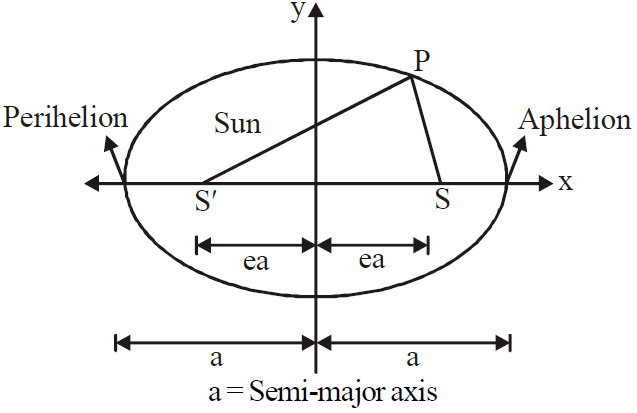
A planet of mass m moving in an elliptical orbit around the sun. The sun of mass M, is at one focus S′ of the ellipse. The other focus is S, which is located in empty space. Each focus is at distance ‘ea’ from the ellipse’s centre, with ‘e’ being the eccentricity of the ellipse and ‘a’ semimajor axis of the ellipse, the perihelion (nearest to the sun) distance rmin., and the aphelion (farthest from the sun) distance rmax. are also shown.
rmax = a + e a = (1 + e) a
rmin = a – e a = (1 – e) a
The distance of each focus from the centre of ellipse is ea, where e is the dimensionless number between 0 to 1 called the eccentricity. If e = 0, the ellipse is a circle.
For earth e = 0.017.
LAW OF AREAS
An imaginary line that connects a planet to the sun sweeps out equal areas in the plane of the planet’s orbit in equal times.
i.e., the rate dA/dt at which it sweeps out area A is constant.
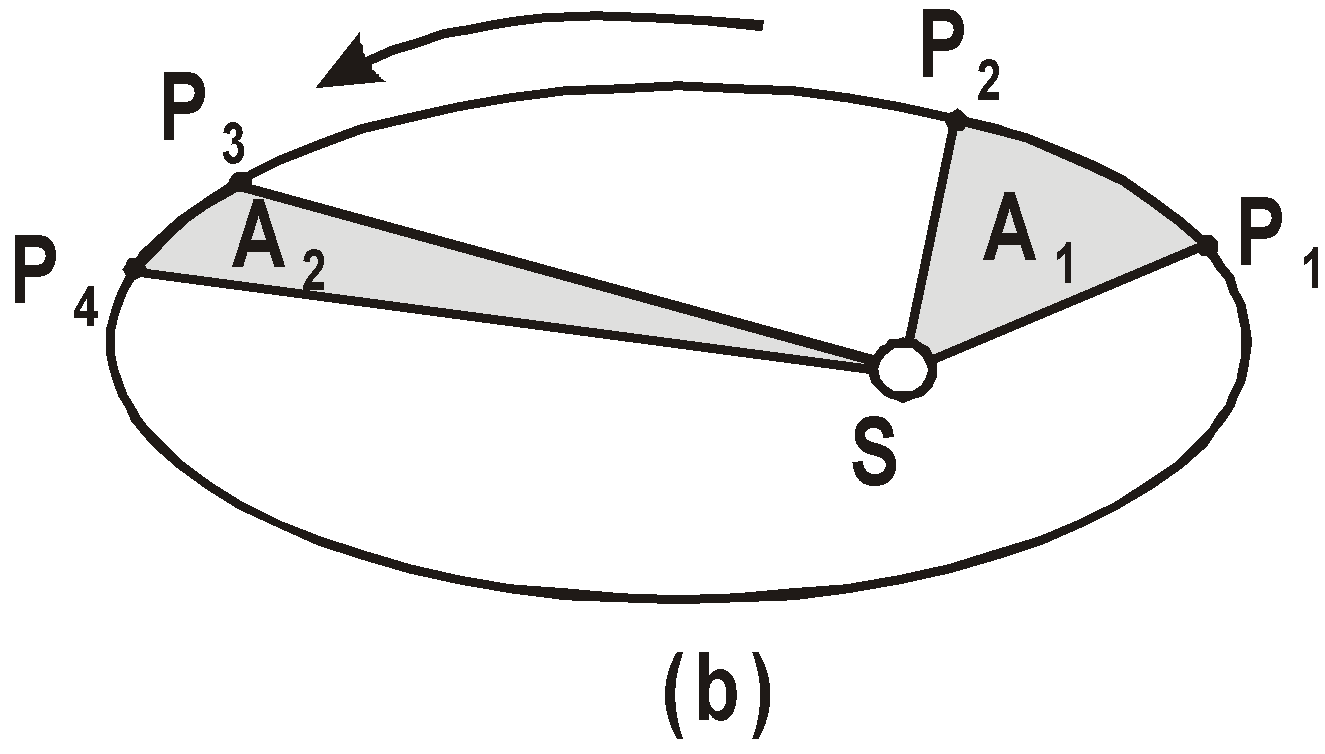
If  then A1 = A2
then A1 = A2
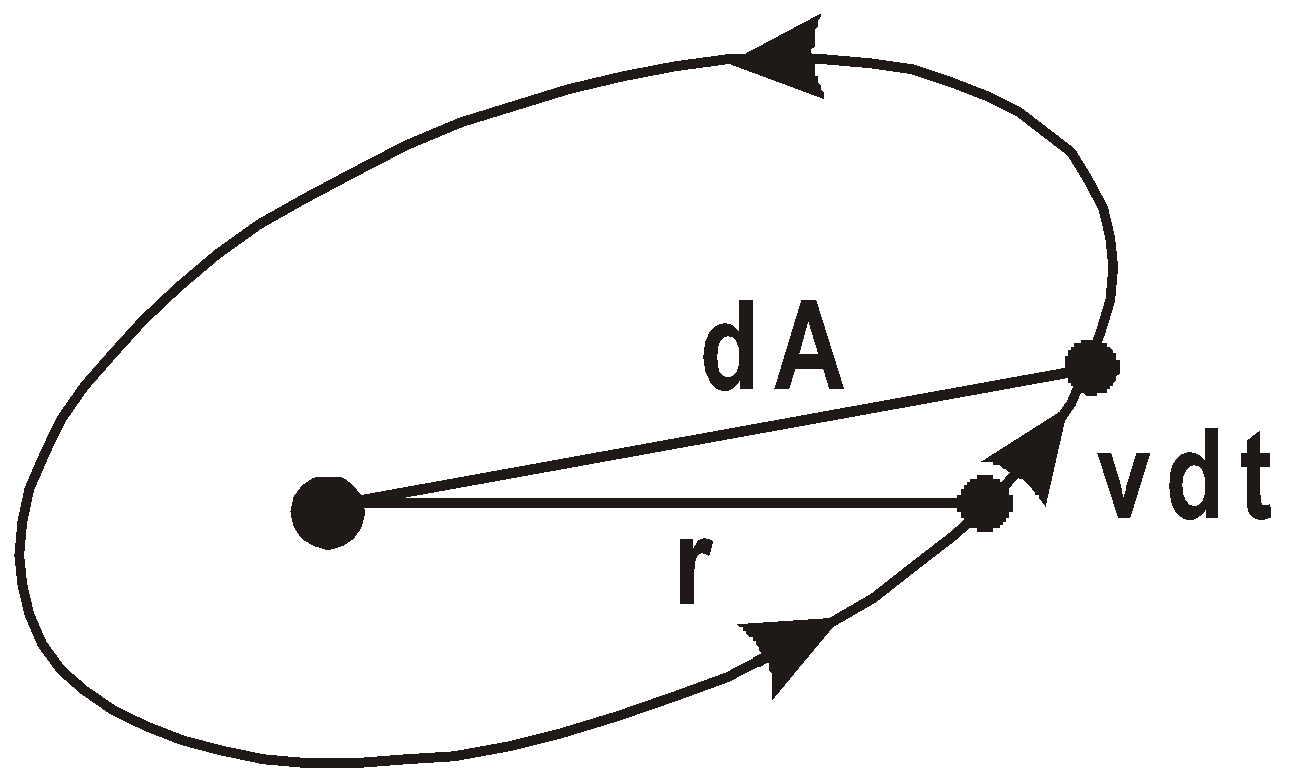
so  ….(1)
….(1)
But as L = constt., (force is central, so torque = 0 and hence angular momentum of the planet is conserved)
Areal velocity (dA/dt) = constant which is Kepler’s IInd law, i.e., Kepler’s IInd law or constancy of areal velocity is a consequence of conservation of angular momentum.
LAW OF PERIODS
The square of the period of revolution of any planet is proportional to the cube of the semi-major axis of the orbit.
i.e., T2 ∝ r3.
or, 

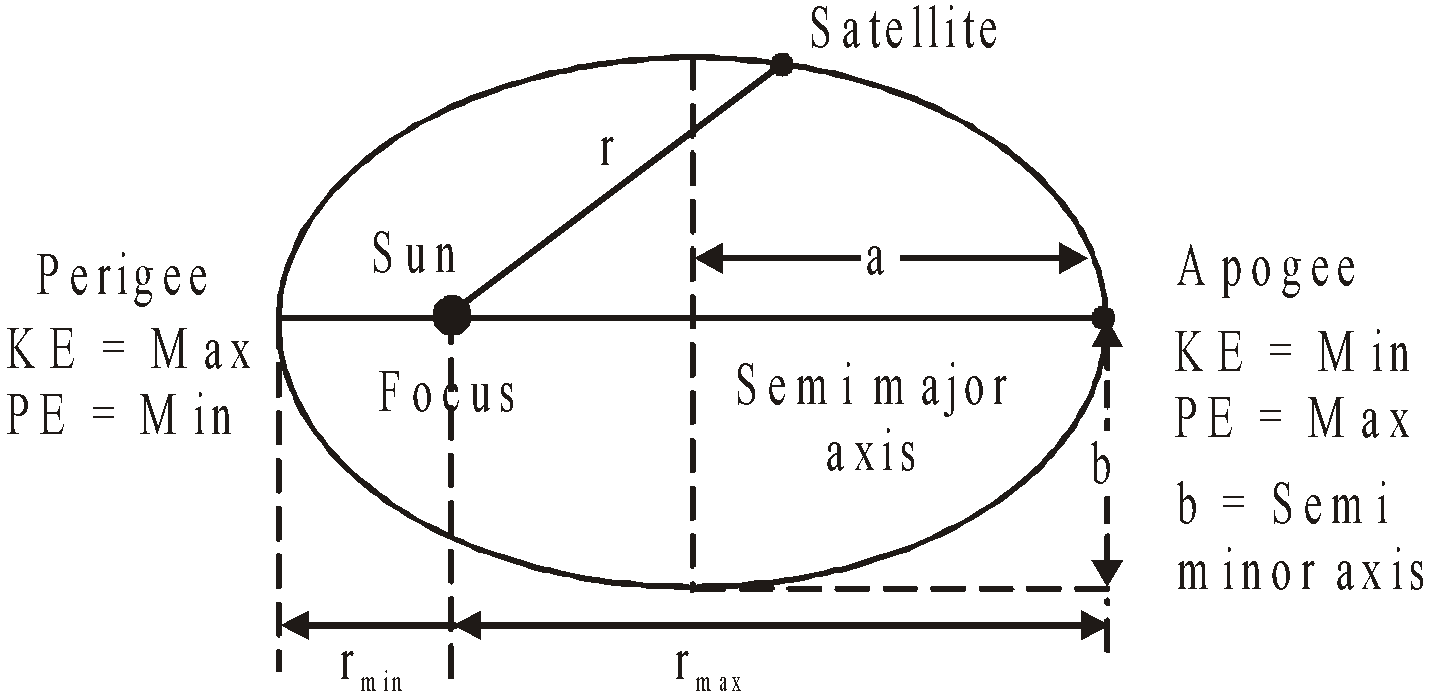
WEIGHTLESSNESS
The “weightlessness” you may feel in an aircraft occurs any time the aircraft is accelerating downward with acceleration g. It is possible to experience weightlessness for a considerable length of time by turning the nose of the craft upward and cutting power so that it travels in a ballistic trajectory. A ballistic trajectory is the common type of trajectory you get by throwing a rock or a baseball, neglecting air friction. At every point on the trajectory, the acceleration is equal to g downward since there is no support. A considerable amount of experimentation has been done with such ballistic trajectories to practice for orbital missions where you experience weightlessness all the time.
The satellite is moving in a circular orbit, it has a radial acceleration

i.e., it is falling towards earth’s centre with acceleration a,
so apparent weight of the body in it Wap = m(g´ – a)
where g´ is the acceleration due to gravity of earth at the position (height) of satellite, i.e. g´ = (GM/r2), so that

i.e., the apparent weight of a body in a satellite is zero and is independent of the radius of the orbit.
KEEP IN MEMORY
- The moon takes 27.3 days to revolve around the earth.
The radius of its orbit is 3.85 × 105 km. - Kepler’s second law is based on conservation of angular momentum.
- Perihelion distance is the shortest distance between the sun and the planet.
- Aphelion distance is the largest distance between the Sun and the planet.

- If e is the eccentricity of the orbit
then 

raphelion + rperihelion = 2r
- If e > 1 and total energy (KE + PE) > 0, the path of the satellite is hyperbolic and it escapes from its orbit.
- If e < 1 and total energy is negative it moves in elliptical path.
- If e = 0 and total energy is negative it moves in circular path.
- If e = 0 and total energy is zero it will take parabolic path.
- The path of the projectiles thrown to lower heights is parabolic and thrown to greater heights is elliptical.
- Kepler’s laws may be applied to natural and artificial satellites as well.
- Gravitational force does not depend upon medium so no medium can shield it or block it.
- The escape velocity and the orbital velocity are independent of the mass of the body being escaped or put into the orbit.